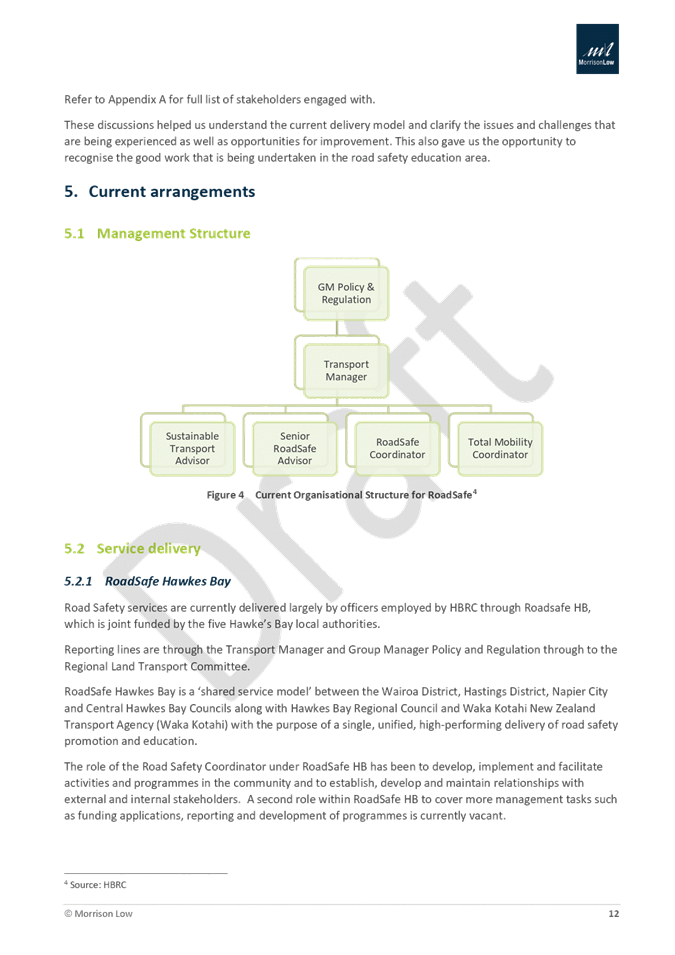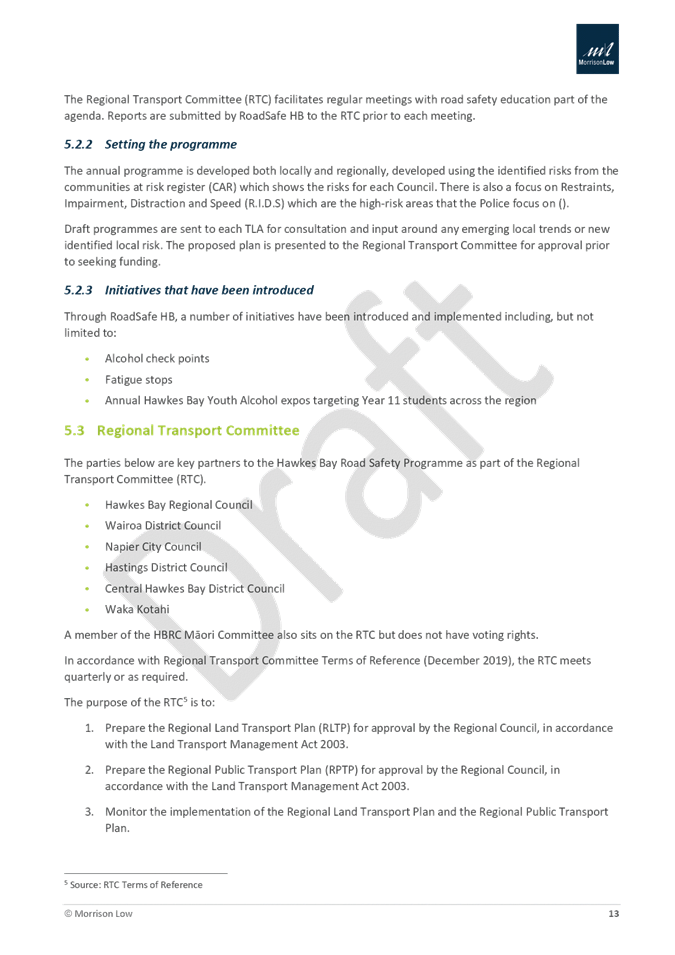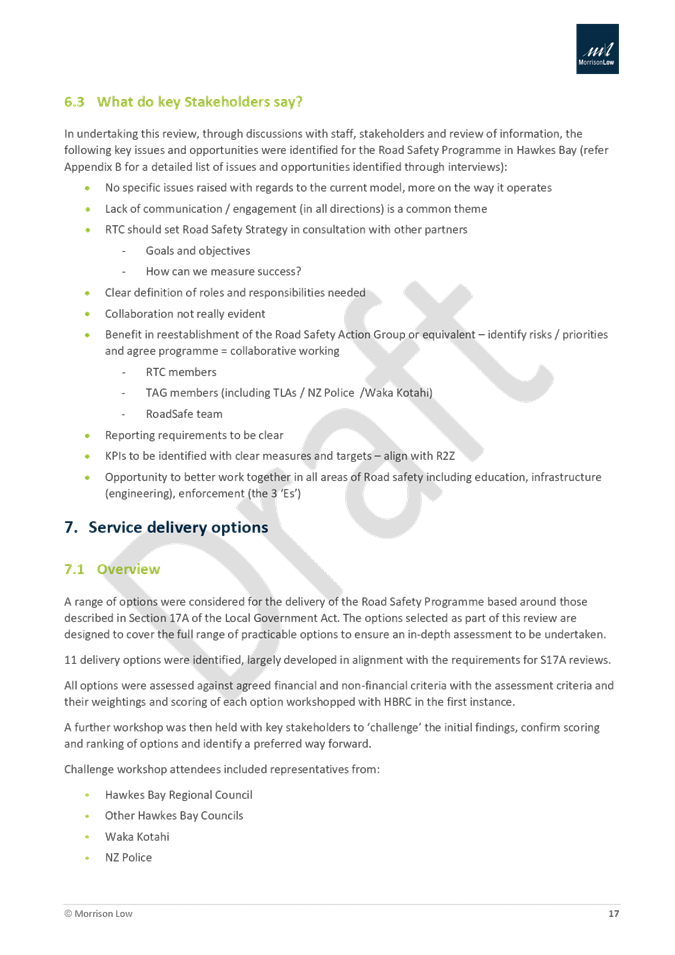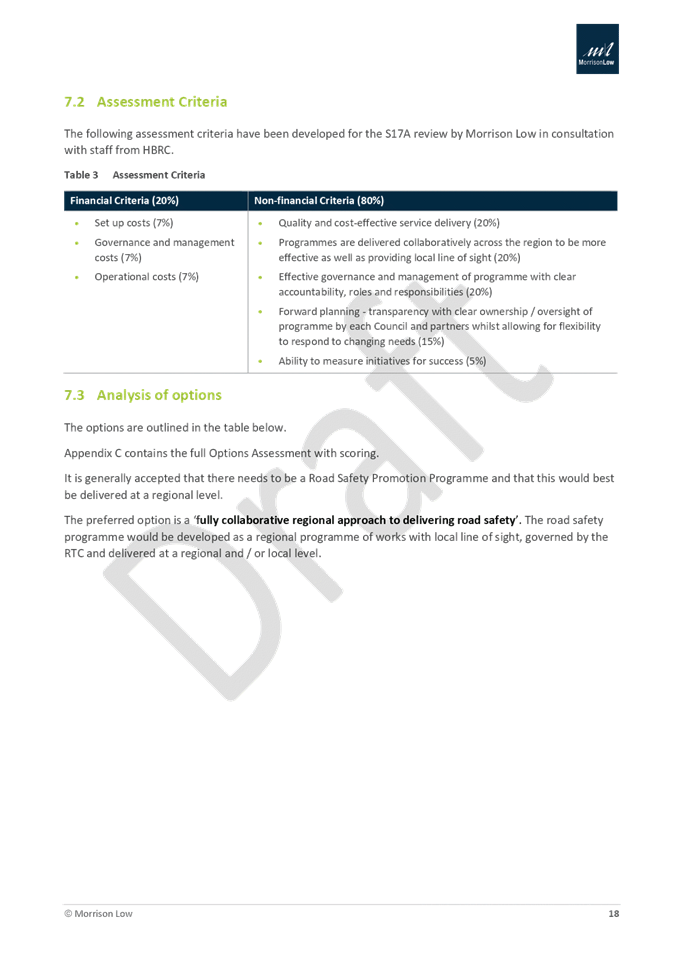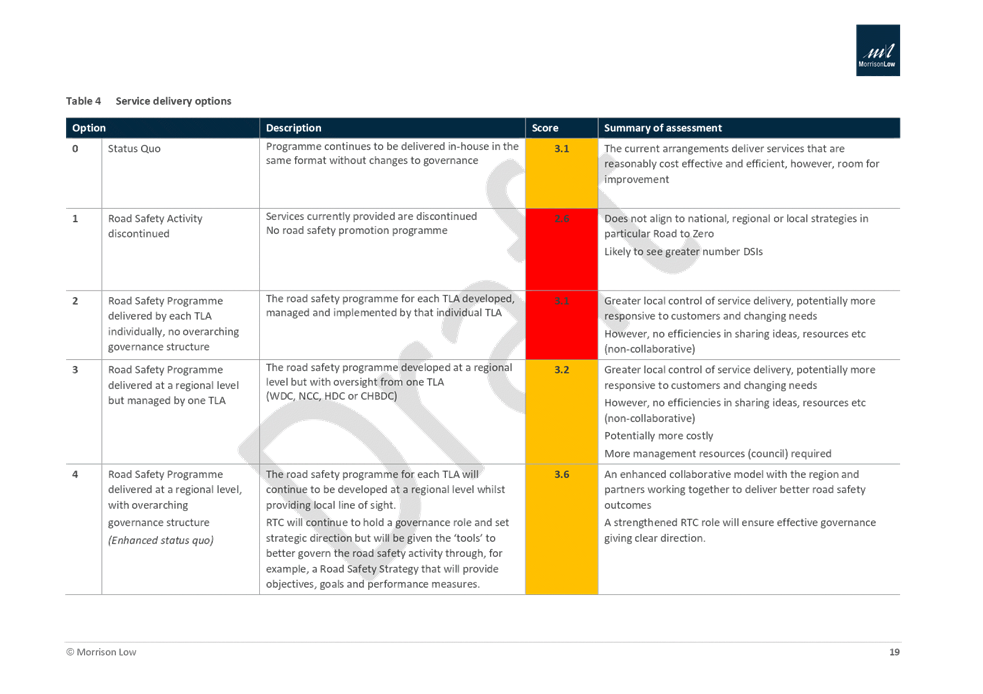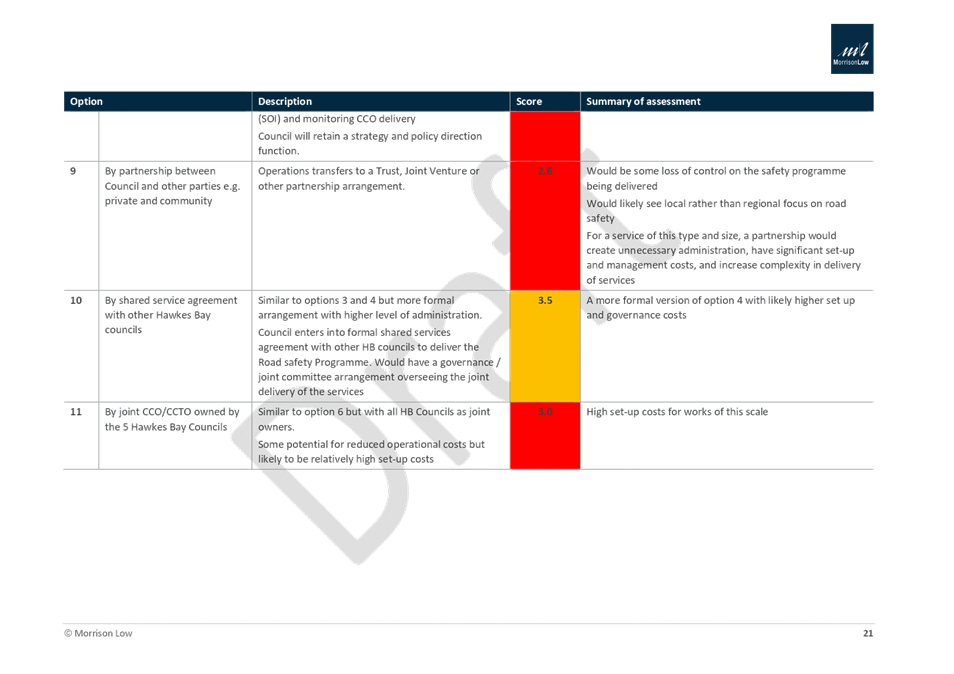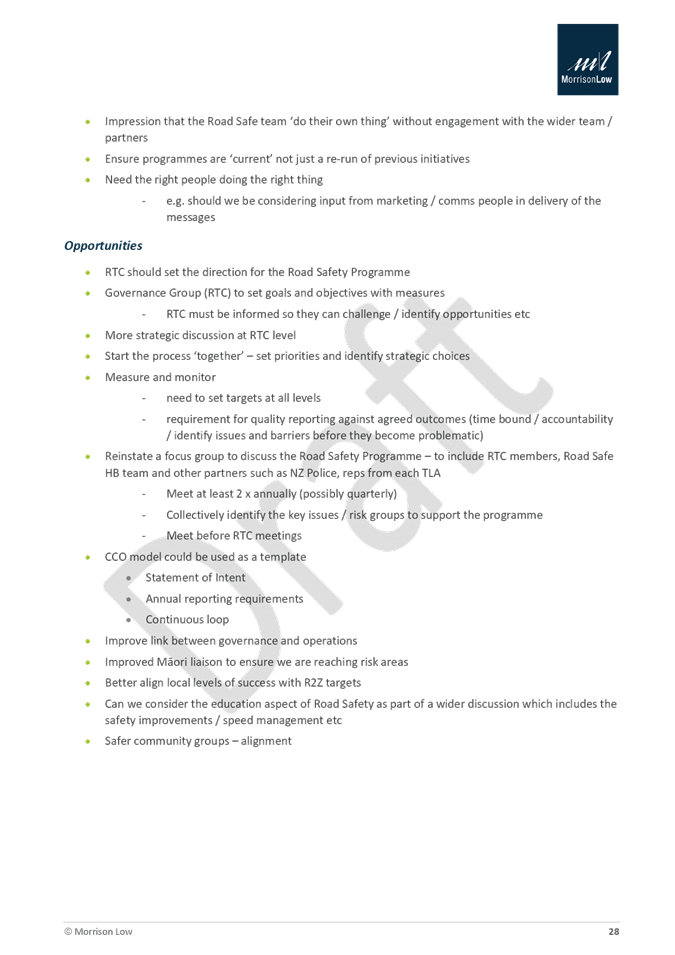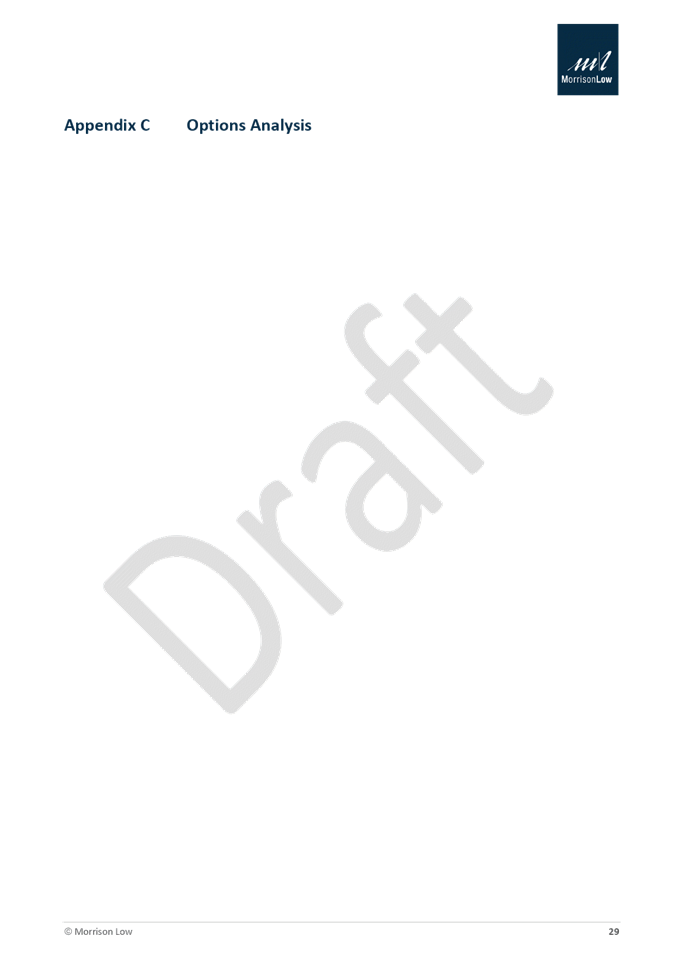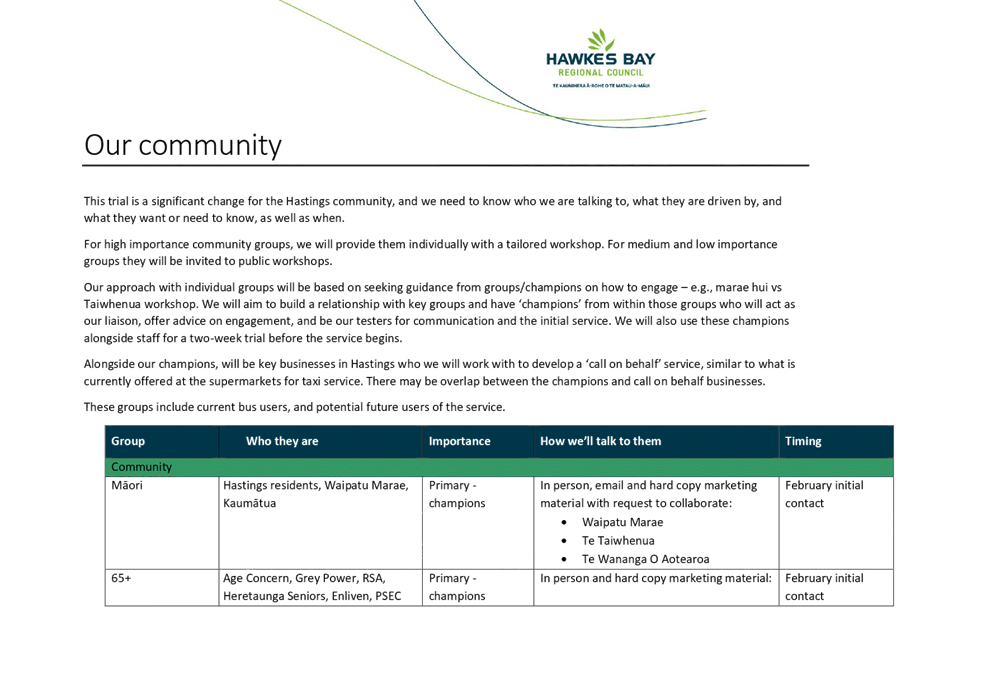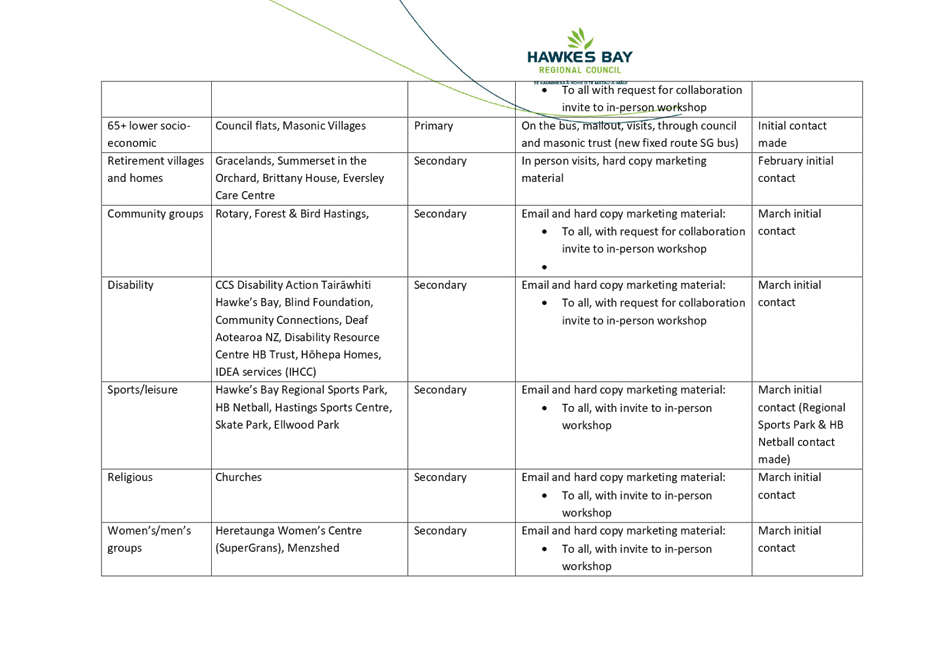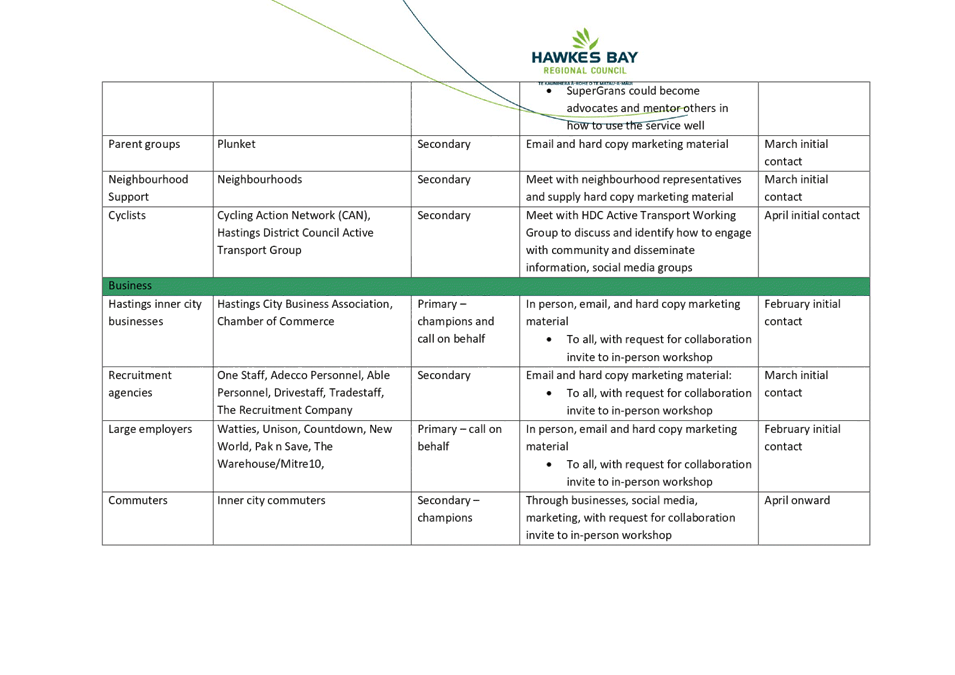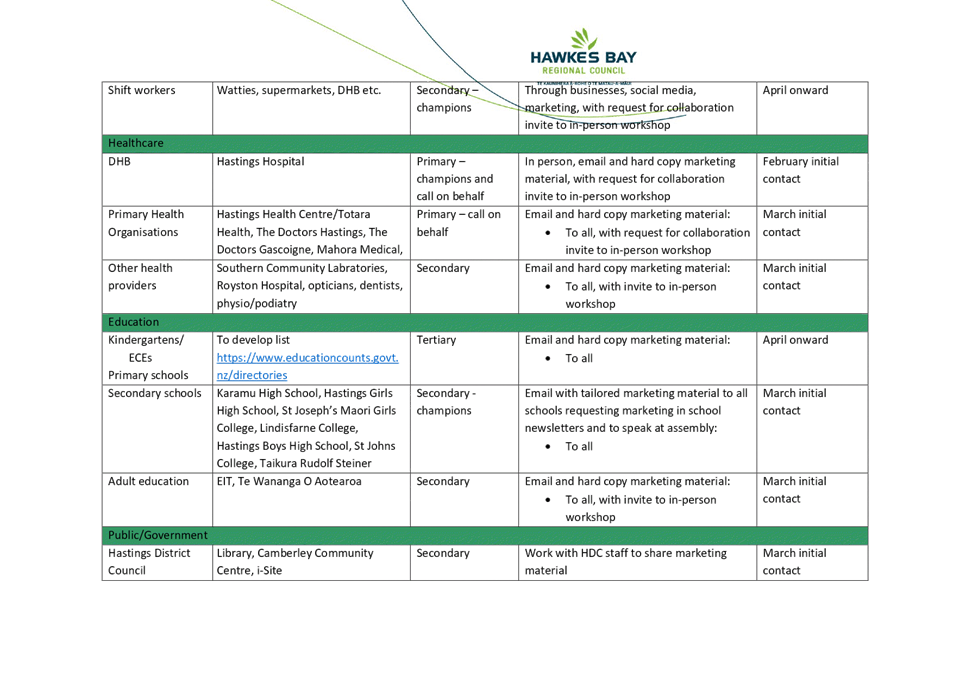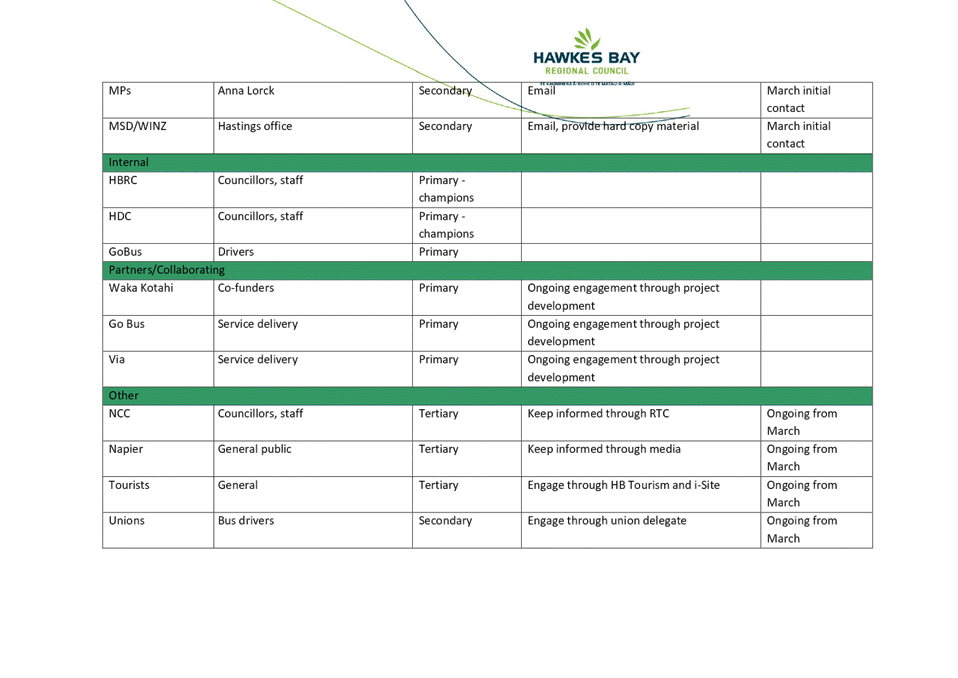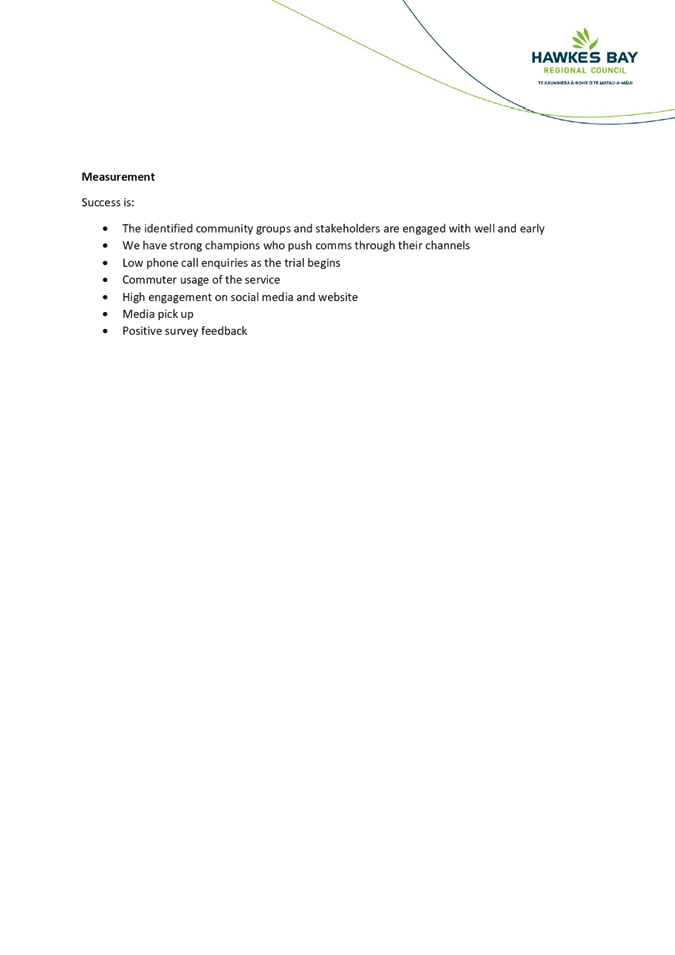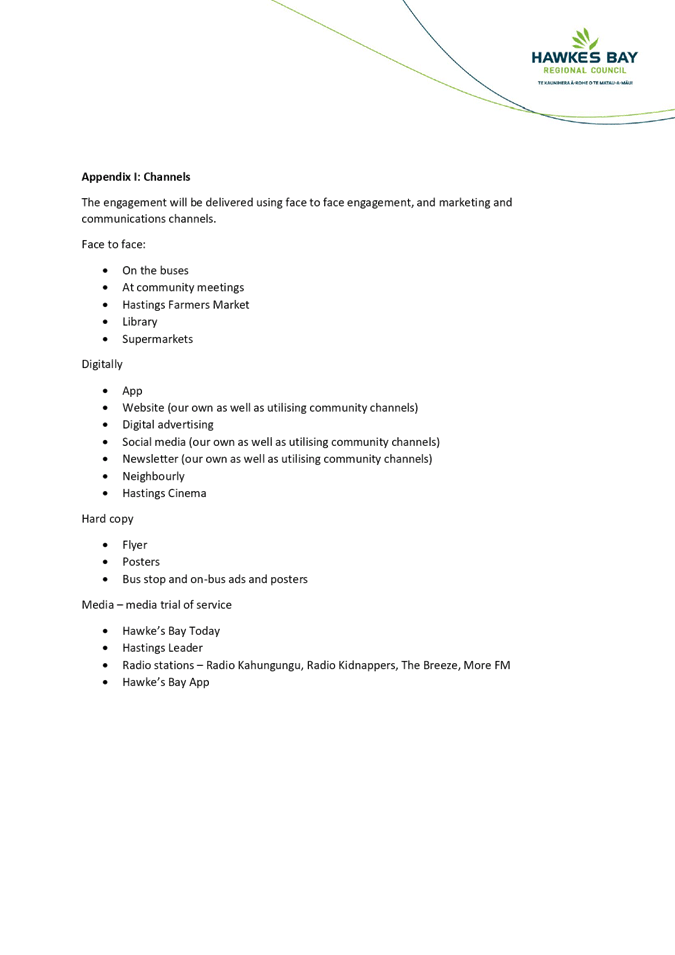Meeting of the
Regional Transport Committee
Date: 11 March 2022
Time: 10.00am
|
Venue:
|
Council
Chamber
Hawke's
Bay Regional Council
159
Dalton Street
NAPIER
|
Agenda
Item Title Page
1. Welcome/Notices/Apologies
2. Conflict
of Interest Declarations
3. Confirmation of Minutes of
the Extraordinary Regional Transport Committee Meeting held on 3 February 2022
4. Follow-ups
from Previous Regional Transport Committee Meetings 3
5. Call
for Minor Items not on the Agenda 25
Decision
Items
6. National
Freight Strategy verbal presentation by Napier Port
7. Road
Safety s17a Review Outcomes Report 27
Information
or Performance Monitoring
8. On
Demand Public Transport update 65
9. March
2022 Public Transport Update 89
10. Roadsafe
Update 97
11. Transport
Manager’s March 2022 Report 101
12. Waka
Kotahi Central Region - Regional Relationships Director's March 2022 Report 107
13. Verbal
Updates by Advisory Representatives
14. Discussion
of Minor Matters Not on the Agenda 133
HAWKE’S BAY REGIONAL
COUNCIL
Regional
Transport Committee
11 March
2022
SUBJECT: Follow-ups from Previous
Regional Transport Committee Meetings
Introduction
1. Attachment 1 is a list of
items raised at previous Regional Transport Committee meetings that require
action or follow-up. All follow-up items indicate who is responsible for each
item, when it is expected to be completed and a brief status comment. Once the
items have been completed and reported to the Committee they will be removed
from the lists.
Decision
Making Process
2. Staff have assessed the
requirements of the Local Government Act 2002 in relation to this item and have
concluded that, as this report is for information only, the decision making
provisions do not apply.
|
Recommendation
That the Regional Transport
Committee receives and notes the “Follow-ups from previous Regional
Transport Committee meetings”.
|
Authored by:
|
Leeanne Hooper
Team Leader Governance
|
|
Approved by:
|
Katrina Brunton
Group Manager Policy &
Regulation
|
|
Attachment/s
|
1⇩
|
Follow-ups from Previous RTC
Meetings
|
|
|
|
Follow-ups from Previous RTC Meetings
|
Attachment
1
|












HAWKE’S
BAY REGIONAL COUNCIL
Regional
Transport Committee
11 March
2022
Subject: Call for Minor Items not on
the Agenda
Reason for Report
1. This item provides the
means for committee members to raise minor matters they wish to bring to the
attention of the meeting.
2. Hawke’s Bay Regional
Council standing order 9.13
states:
2.1. “A meeting may discuss an item that is
not on the agenda only if it is a minor matter relating to the general business
of the meeting and the Chairperson explains at the beginning of the public part
of the meeting that the item will be discussed. However, the meeting may not
make a resolution, decision or recommendation about the item, except to refer
it to a subsequent meeting for further discussion.”
Recommendations
3. That the Regional Transport
Committee accepts the following “Minor Items Not on the Agenda” for
discussion as Item 14.
|
Peter
Martin
SENIOR
GOVERNANCE ADVISOR
|
Katrina
Brunton
GROUP
MANAGER POLICY & REGULATION
|
HAWKE’S
BAY REGIONAL COUNCIL
Regional
Transport Committee
11 March
2022
Subject:
Road Safety s17a Review Outcomes Report
Reason for Report
1. This report seeks approval from the
Regional Transport Committee to progress the proposed outcome resulting from
the Service Delivery Review of HB Roadsafe functions subject to Section 17a of
the Local Government Act 2002.
Officers’
Recommendations
2. Staff recommend that the committee
approves the proposed delivery outcome that resulted from Morrison Low’s
Service Delivery Review of the Hawke’s Bay Regional Council’s Road
Safety function.
Executive
Summary
3. This report introduces the Morrison
Low report, attached, which covers the feedback, findings, evaluation, and
recommendations of the delivery of Hawke’s Bay’s Road Safety
programme.
Background
/Discussion
4. At its 11 December 2020 meeting, the
Regional Transport Committee (RTC) sought advice in relation to their oversight
and governance of Hawke’s
Bay’s Road Safety
programme (RSP). The Committee also sought further advice about the effective
delivery of their governance obligations for Road Safety.
5. In response to the request for
oversight and governance of the Road Safety Programme, a workshop was held on
12 March 2021. The workshop provided an opportunity to discuss the options and
preferred approach for the involvement of the Committee in the Road Safety
Programme.
6. The outcome from that workshop was
agreement that direction setting, oversight and accountability for the RoadSafe
programme should sit with the RTC at the Governance level.
7. Following that decision, the RTC
agreed to a service delivery review in accordance with the requirements of
Section 17a of the Local Government Act 2002.
8. Morrison Low undertook the Section 17a
review of the delivery of the Road Safety programme with all stakeholders and
the findings and recommendations from that review are attached.
Options
Assessment
9. Road Safety delivery options are
discussed in the attached Morrison Low report.
Strategic
Fit
10. The Roadsafe functions contribute to
sustainable and climate resilient infrastructure. To achieve this strategic
vision, it is essential that HBRC, the TLAs, Waka Kotahi, NZ Police and ACC
have good working relationships to enable the successful achievement of this
goal.
11. There are a range of possible delivery
methods available to the Council to achieve the Roadsafe functions. The
Service Delivery review outcomes will enable the RTC and councils to decide on
the best option to achieve the objectives and targets in a desired timeframe,
based on the framework.
Significance
and Engagement Policy Assessment
12. The significance of this proposed
review has been determined to be of medium significance; reflected in the
proposed methodology and the intent to undertake wide engagement with all
Roadsafe partners and key stakeholders.
Financial
and Resource Implications
13. Financial and resource implications
are outlined in the attached Morrison Low report.
Consultation
14. Consultation undertaken with
stakeholders is outlined in the attached report.
Considerations
of Tangata Whenua
15. There are no social, cultural, or
economic effects on Tangata Whenua as a result of this review, but consultation
was undertaken with key stakeholders, some of which have a primary focus on the
social, cultural and economic wellbeing of Tangata Whenua in regard to road
safety.
Morrison
Low
16. Morrison Low will not be joining this
meeting, however they can be available online to discuss the report. This
can be a members-only session if required.
17. Should the Committee wish to discuss
matters with Morrison Low with the public excluded, the following resolution
must be passed.
17.1. That the Regional Transport Committee
excludes the public from this section of the meeting being Road Safety s17a
Review Outcomes Report with the general subject of the item to be
considered while the public is excluded; the reasons for passing the resolution
and the specific grounds under Section 48 (1) of the Local Government Official
Information and Meetings Act 1987 for the passing of this resolution being:
|
General Subject of the Item to
be Considered
|
Reason for Passing This
Resolution
|
Grounds Under Section 48(1) for
the Passing of the Resolution
|
|
Road Safety s17a Review Outcomes Report
|
7(2)(f)(ii) The exclusion of the public from this
discussion is necessary to maintain the effective conduct of public affairs
through the protection of such members, officers, employees, and persons from
improper pressure or harassment
|
The Council is specified, in the First Schedule to this Act, as
a body to which the Act applies.
|
|
Road Safety s17a Review Outcomes Report
|
7(2)(a) That the public conduct of this
agenda item would be likely to result in the disclosure of information where
the withholding of the information is necessary to protect the privacy of
natural persons.
|
The Council is specified, in the First Schedule to this Act, as
a body to which the Act applies.
|
Decision Making Process
18. Council and its committees
are required to make every decision in accordance with the requirements of the
Local Government Act 2002 (the Act). Staff have assessed the requirements in
relation to this item and have concluded:
18.1. The decision does not significantly
alter the service provision or affect a strategic asset, nor is it inconsistent
with an existing policy or plan.
18.2. The use of the special consultative
procedure is not prescribed by legislation.
18.3. The decision is not significant under
the criteria contained in Council’s adopted Significance and Engagement
Policy.
18.4. The persons affected by this decision
are all persons with an interest in the region’s management and delivery
of Road Safety.
18.5. Given the nature and
significance of the issue to be considered and decided, and also the persons
likely to be affected by, or have an interest in the decisions made, the
Committee can exercise its discretion and make a decision without consulting
directly with the community or others
having an interest in the decision.
Recommendations
That
the Regional Transport Committee:
1. Receives and considers the “Road
Safety s17a Review Outcomes Report” staff report.
2. Agrees that the decisions to be made
are not significant under the criteria contained in Hawke’s Bay Regional
Council’s adopted Significance and Engagement Policy, and that the
Committee can exercise its discretion and make decisions on this issue without
conferring directly with the community.
3. Approves the preferred service
delivery model of a fully collaborative regional approach to road safety
including:
3.1. Improved
structure to drive an enhanced collaborative model across the region through
the Councils, Waka Kotahi, NZ Police and their partners working together to
deliver better road safety outcomes through engineering, education and
enforcement
3.2. The road
safety programme will be developed and monitored at a strategic regional level
and then implemented locally at an operational level
3.3. A
strengthened Regional Transport Committee (RTC) role will ensure effective governance
and decision-making, giving clear direction and goals
3.4. A focused
Road Safety Group will support a more effective programme across the region,
coming together to identify priorities and set the annual programme and then to
review the annual programme (midway through the year) against objectives and
measures and adjust it to suit current / emerging needs
3.5. RoadSafe HB
will provide a coordination and community engagement role in delivery of the
programme with strategic support from the RTC and the councils.
If
required to move into PE for discussion:
1. That the Regional Transport Committee
excludes the public from this section of the meeting being Road Safety s17a
Review Outcomes Report with the general subject of the item to be
considered while the public is excluded; the reasons for passing the resolution
and the specific grounds under Section 48 (1) of the Local Government Official
Information and Meetings Act 1987 for the passing of this resolution being:
|
General Subject of the Item to
be Considered
|
Reason for Passing This
Resolution
|
Grounds Under Section 48(1) for
the Passing of the Resolution
|
|
Road Safety s17a Review Outcomes Report
|
7(2)(f)(ii) The exclusion of the public from this
discussion is necessary to maintain the effective conduct of public affairs
through the protection of such members, officers, employees, and persons from
improper pressure or harassment
|
The Council is specified, in the First Schedule to this Act, as
a body to which the Act applies.
|
|
Road Safety s17a Review Outcomes Report
|
7(2)(a) That the public conduct of this
agenda item would be likely to result in the disclosure of information where
the withholding of the information is necessary to protect the privacy of
natural persons.
|
The Council is specified, in the First Schedule to this Act, as
a body to which the Act applies.
|
2. That a representative of Morrison Low
remains in attendance for the Public Excluded session as the author of the
report and subject matter expert.
Authored by:
|
Katie Nimon
Transport Manager
|
|
Approved by:
|
Katrina Brunton
Group Manager Policy &
Regulation
|
|
Attachment/s
|
1⇩
|
Morrison Low Report on the Section
17a Review of Hawke’s Bay Road Safety Programme Service Delivery
|
|
|
|
Morrison Low Report on the Section 17a
Review of Hawke’s Bay Road Safety Programme Service Delivery
|
Attachment
1
|











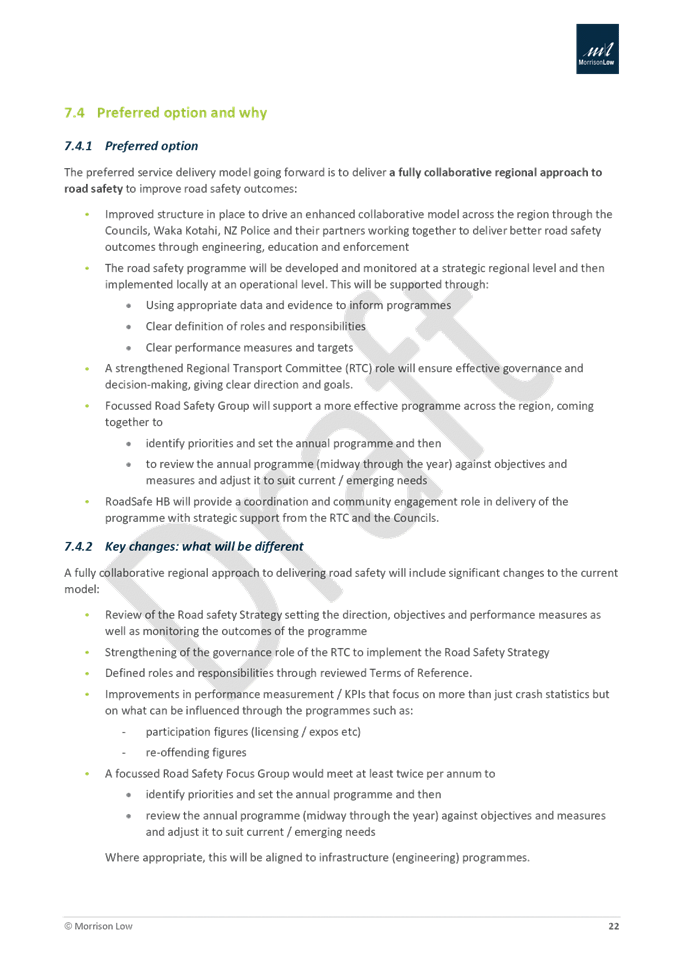
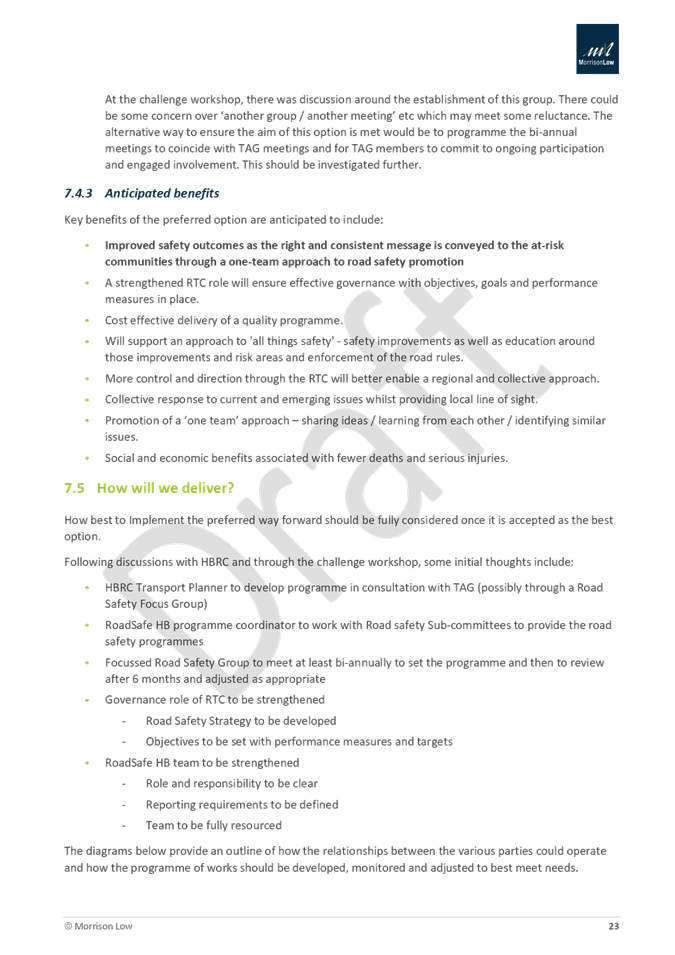
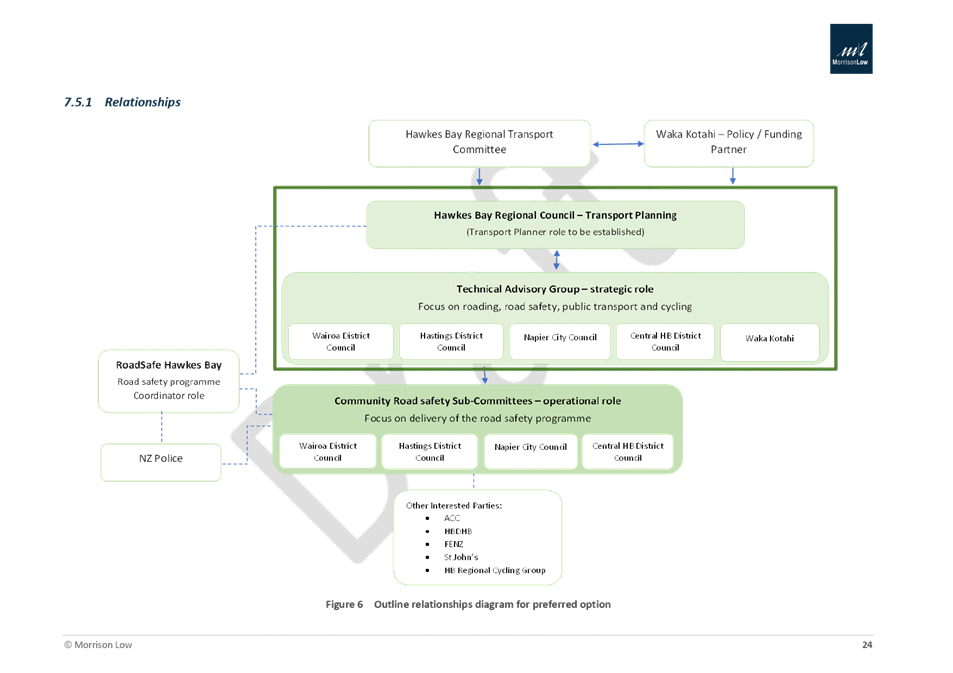
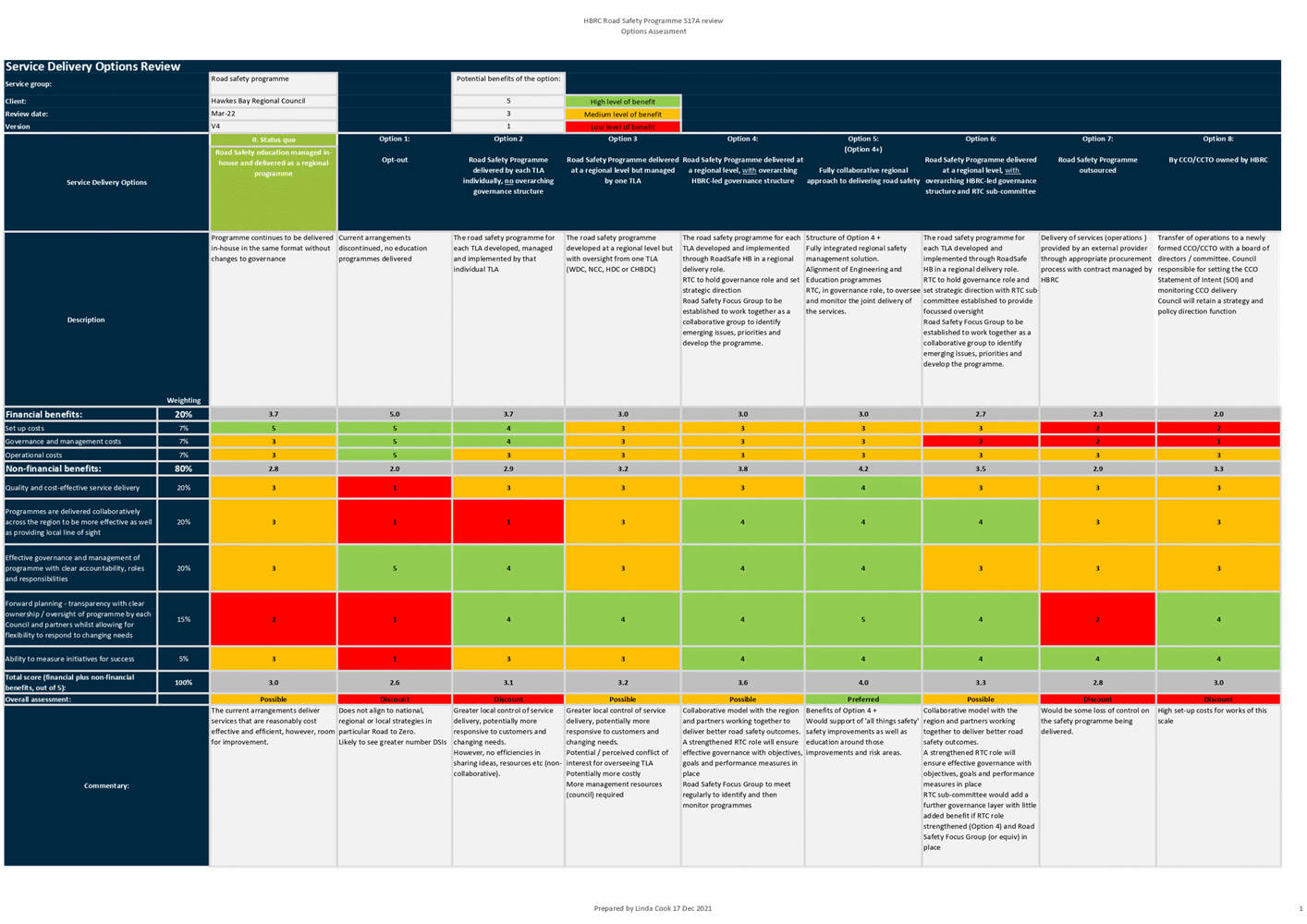
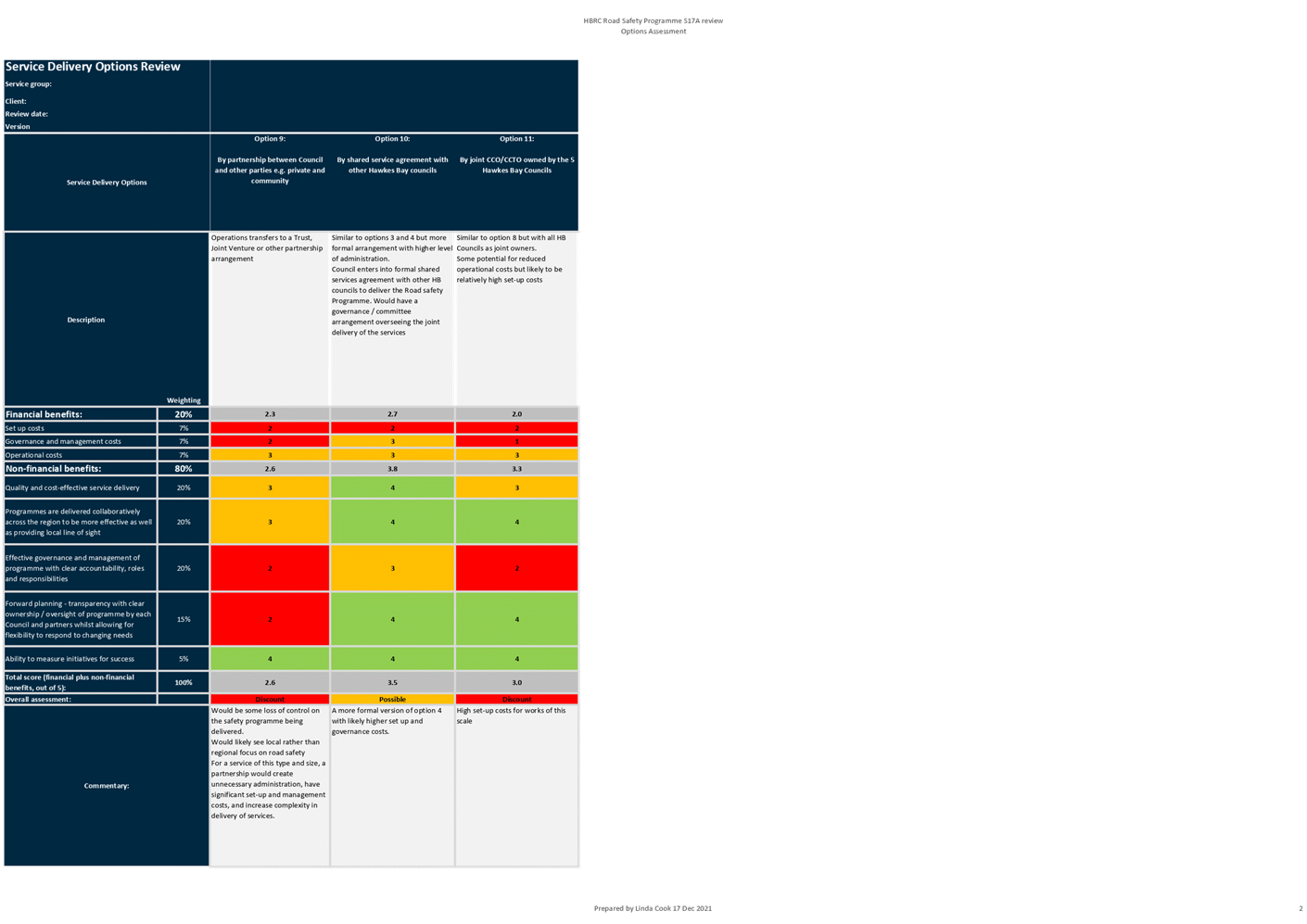
HAWKE’S BAY REGIONAL COUNCIL
Regional
Transport Committee
11 March
2022
Subject:
On Demand Public Transport update
Reason for Report
1. This report provides an overview of
and update on, the on-demand public transport trial. This
was a key decision in the LTP and is a significant activity of Hawke’s
Bay Regional Council.
Executive Summary
2. Hawke’s
Bay Regional Council is launching an on-demand public transport service called
MyWay in Hastings in June 2022. This project was a key decision made in
the 2021-2031 Long-Term Plan (LTP) and involves significant investment. The
Regional Transport Committee (RTC) requires regular updates on the progress of
the project to ensure delivery is on track and within the scope of the LTP
decision.
Strategic Fit
4. The Region’s public transport
system contributes to two of our Strategic priorities, being:
4.1. By 2025, regional air quality
consistently meets World Health Organisation Guidelines
4.2. By 2025, HBRC is carbon zero and plays
a leadership role in the region’s goal of net zero greenhouse gases by
2050.
5. Travel demand management and mode
shift are the most important ways to lower vehicle kilometres travelled (VKT).
This service will not only avoid dead running of a bus with no passengers on
it, but it will also offer a more attractive and sustainable alternative to the
second family car. By having an on-demand ride share mode of public transport,
we aim to reduce the number of short trips people make in a car, as well as the
number of large, aged diesel buses operating well below capacity.
Background
6. Hawke’s Bay Regional Council
resolved to fund the pilot of on-demand public transport to a total of $6.8
million (100% targeted to Hastings and Napier urban ratepayers) over 10 years
assuming the success of the pilot. The pilot proposed to roll out to Hastings
at an extra cost of $361,000 in 2021 and $249,000 in 2022 replacing current
routes 16A, 16B and 17. If successful it would be, introduced to Napier at an
extra cost of $582,000 in 2023 and $447,000 in 2024 replacing current routes
13, 14 and 15.
7. The
Regional Council is responsible for providing accessible and useful public
transport to Hawke’s Bay residents. There
are currently public bus services running both within and between Hastings and
Napier, but patronage has been declining over several years in both cities. In
the past five years the annual patronage has dropped from 690,000 to 530,000.
Major changes are needed to revitalize public transport in Hawke’s Bay. For many years, public transport has addressed inclusive
access for all, and this is represented in our current network.
8. The
National Position on Public Transport includes five outcomes: inclusive access,
economic prosperity, resilience and security, healthy and safe people, and
environmental sustainability. We have now declared a climate emergency, and
it’s no longer enough to provide a service for only those that have no
other option. The focus needs to be on a mode shift, as well as travel demand
management. With this in mind, we need to make Hawke’s Bay’s public
transport network an easier and more attractive option for all people.
9. In
response to the issue of declining use of public transport and the need to
reduce emissions from transport, the Regional Council looked at innovative and
new technologies and decided the most appropriate solution was to trial an
on-demand public transport system. If the initial trial in Hastings
is successful, on-demand transport would then be trailed in Napier in 2023.
10. We are
trialling on-demand, (to be
known as MyWay Hawke’s Bay),
as a new kind of public transport to fit in with people’s busy lives. It
will make it easier and simpler to catch the bus and get people to more places
in Hastings. MyWay understands users’ needs, connects them to other bus
services, and arrives when they’re ready to go.
11. To do
this, we’ve partnered with Via, a transport technology company. By using
their demand responsive software, the MyWay services matches customers who are
travelling in the same direction and calculates an optimised flexible route to
pick up and drop off customers close to their destination. We want to see
how this alternative transport offering works. We will be working with our
community listening to their feedback on how easy to use they find the system,
if they find it useful, and if they want to see it stick around. We will be
testing and trialling things to make sure MyWay works as smoothly as possible.
Journeys are likely to be shorter and quicker than the bus service.
12. We have
been planning this trail for two years. We are about to begin engaging with the
community ahead of the launch of the service having gone through a thorough
planning process considering all the factors to develop a fit for purpose
service. Our focus over the coming months is on community
engagement to ensure the trial is successful. This trial is a significant change for the
Hastings community and requires a mode shift from current bus users as well as potential
users. We have developed an engagement plan (attached) to
ensure we reach the right people to get them out of cars and using public
transport.
Discussion
13. Key factors of the service that have
been finalised are:
13.1. The on demand public transport service
will be known as MyWay Hawke’s Bay
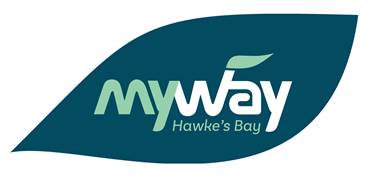
13.2. MyWay will launch on 6 June 2022
13.3. The service will operate from Monday
to Friday, based on the timetable of the existing Hastings routes being
replaced.
13.4. The service will be operated by Go Bus
Transport, as a variation to the current contract.
13.5. Three minivans will operate the
service, one of which will be wheelchair accessible, and two will be low-floor
accessible vehicles.
13.6. The software infrastructure will be
provided and powered by Via (TransitTech) which have a white label app which
allows it to be MyWay Hawke’s Bay branded.
13.7. Routes 16a, 16b, and 17, will be
replaced by MyWay.
13.8. School students will be able to access
the service
13.9. There will be an ‘0800’
phone line for booking without an app
13.10. The
boundary for the service is outlined in green.
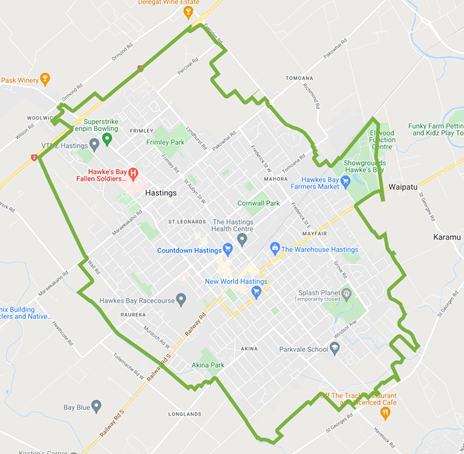
14. The price point is yet to be
finalised. However, it is currently proposed to be a ride cost of $2 per
person, which represents the added value of the increased frequency, and
ability to travel anywhere in Hastings from within 200m from the rider’s
location.
14.1. The current fare for single zone
travel is $1
14.2. We aim to have free transfers for
anyone using this service to connect to another service, to reduce inequity.
This will keep the total travel price capped at $2
14.3. HBDHB have indicated they will cover
the cost of the $2 fare for the MyWay service for staff and patients
14.4. Engagement has presented feedback that
this could be costly for a family traveling as a group, given this is a per
person cost. We acknowledge this, but also note that it is the same cost as a
2-zone trip as a family on the regular bus service. We are continuing to
evaluate this feedback and looking at potential options for this issue.
15. The engagement plan (attached) is
guiding who we talk to and how we talk to them. We are currently undergoing
pre-engagement to further inform our engagement plan, and secure buy-in. We are
working with large and influential organisations such as:
15.1. Hawke’s Bay District Health
Board
15.2. Hastings District Council
15.3. Hastings Business Association
15.4. Current bus users on routes 16a, 16b,
and 17.
16. During pre-engagement, we discovered
technology inequities among certain user groups. There are a small number of
people who currently use the service, that don’t have access to a cell
phone or landline and will be otherwise unable to book the service. This user
group primarily consists of 65+ in low-socioeconomic households such as HDC
senior housing residents. This resulted in HBRC investigating the following
options.
16.1. Offering a fixed route service that
would operate during the off-peak window, using one of the on-demand vehicles.
16.1.1. This option goes against the mode
shift model and doesn’t address the equity issue long-term. This also
diminishes the offering for the on-demand service during off-peak times (9am to
3pm).
16.2. Working with HDC to address the
inequity directly. This will help us better understand who lacks access to
transport, and how they currently access other services. Solutions include
shared phones, a buddy system, or a call-on-behalf carer.
16.2.1. This is the preferred option, and we
are working with HDC on an ongoing basis.
16.3. Providing technology to access
services, such as providing cell phones to those who currently don’t have
communication access.
16.3.1. This option presents issues with the
ongoing cost involved in keeping a cell phone topped up, as well as the potential
support the user needs given their lack of experience with such technology.
17. Our current overall project status is
sitting at on track, but we are flagging it as amber in the HBRC Projects
Status Report due to risks set out following.
Schedule:
Amber
17.1. This is flagged amber as our preferred
launch date is still dependent largely on external forces. One of our largest
risks is a delay of the buses that are imported. GoBus has given us verbal
assurances that the three buses will be road ready in May in time for a
May/June launch however it is still reliant on external suppliers. Given the
Omicron emergence, HBRC has escalated its risk response and flagged workforce
availability will likely be the limiting factor. Depending on timing of COVID
peak, this may affect the work schedule and/or launch.
Budget:
Amber
17.2. This has temporarily been moved into
amber due to unbudgeted cost which we may need to work through because of
delayed technology and out of scope costs arising in response to engagement. It
has been confirmed that the fare will be $2, however, the users who transfer to
other services will transfer at no extra cost, effectively reducing fare
revenue on other connecting services. Concessions (Supergold card etc) will
still apply.
Risk:
Amber
17.3. Most risks have been identified and
mitigation strategies have been developed. The overall risk is flagged amber
largely due to the uncertainty of the start of the trial due to guaranteed
arrival of the buses and the upgraded COVID pandemic status at HBRC (in which
Omicron is anticipated to predominantly affect workforce availability).
Scope:
Green
17.4. On track. The project has been well
scoped, and a process identified to work through any remaining questions. The
preferred date to commence is May/June 2022.
Next
Steps
18. Engagement with key groups, such as
the Camberley community will begin in March. Engagement with champions and
call-on-behalf businesses /facilities will also begin in March.
19. Wider community engagement will take
place in April 2022.
20. Vehicles are set to arrive early May,
with technology fit out and branding to take place in the following weeks;
ready for a 2-week pilot trial to begin on 23 May 2022.
Decision
Making Process
21. Staff have assessed the requirements
of the Local Government Act 2002 in relation to this item and have concluded
that, as this report is for information only, the decision-making provisions do
not apply.
Recommendation
That
the Regional Transport Committee receives and notes the “On Demand
Public Transport Update” staff report.
Authored by:
|
Katie Nimon
Transport Manager
|
|
Approved by:
|
Katrina Brunton
Group Manager Policy &
Regulation
|
|
Attachment/s
|
1⇩
|
On Demand Engagement Plan
|
|
|
|
On Demand Engagement Plan
|
Attachment
1
|
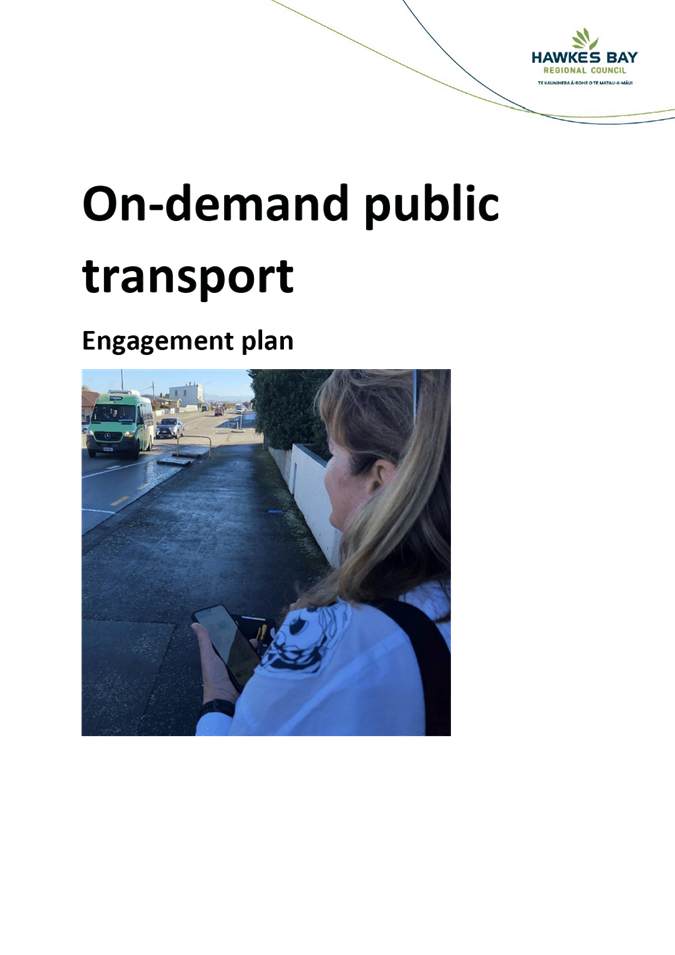
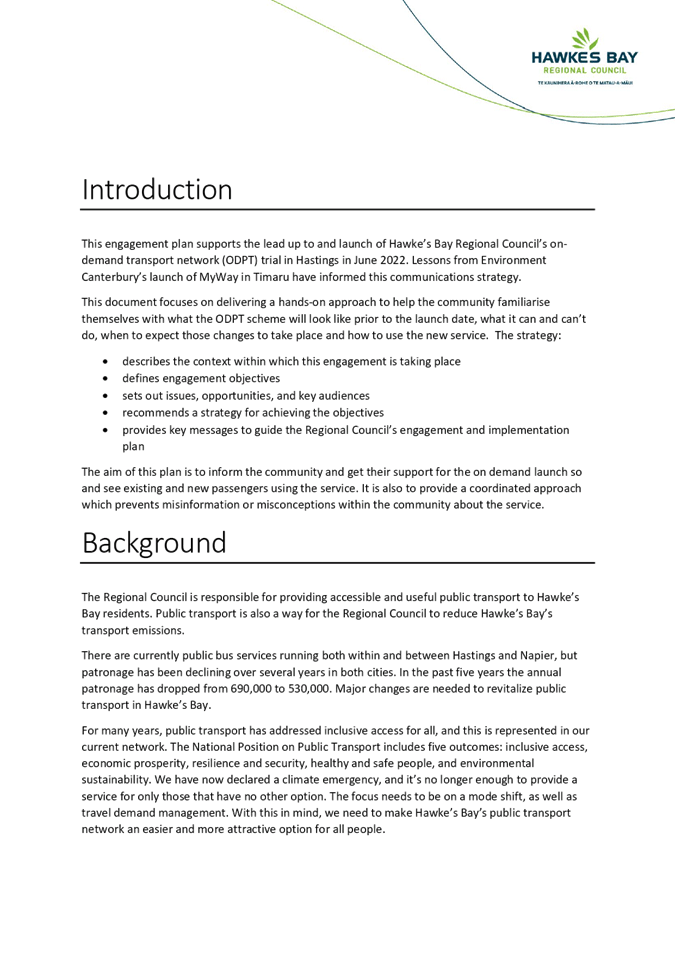
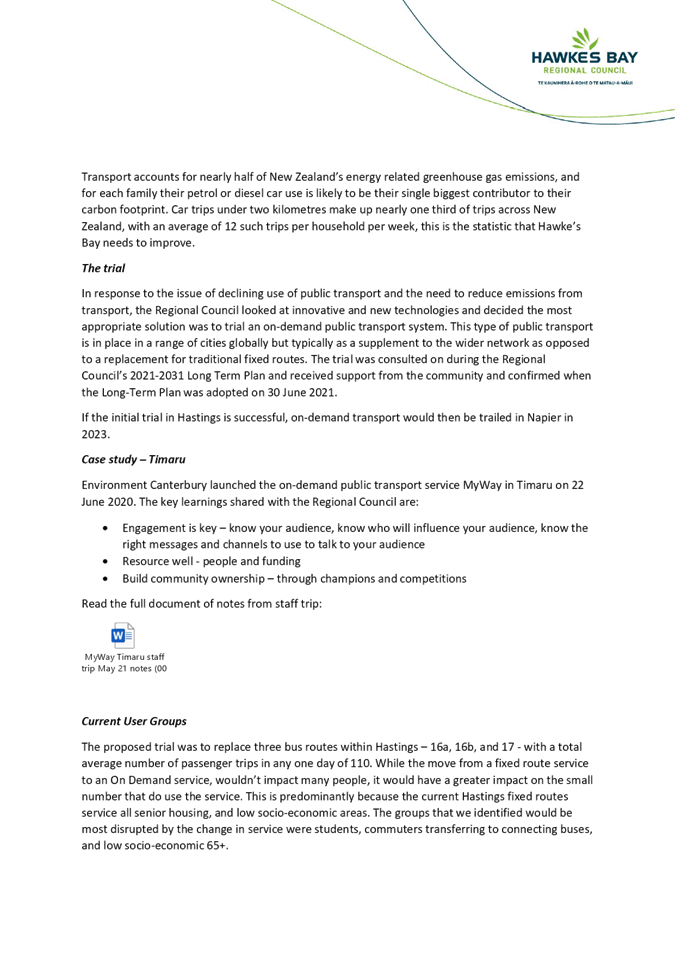
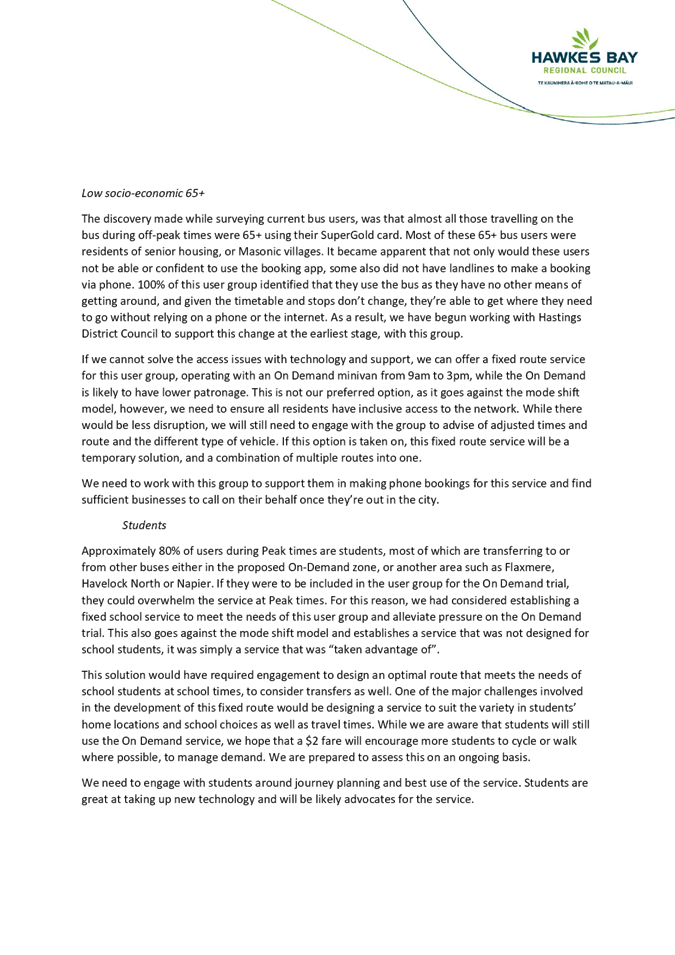
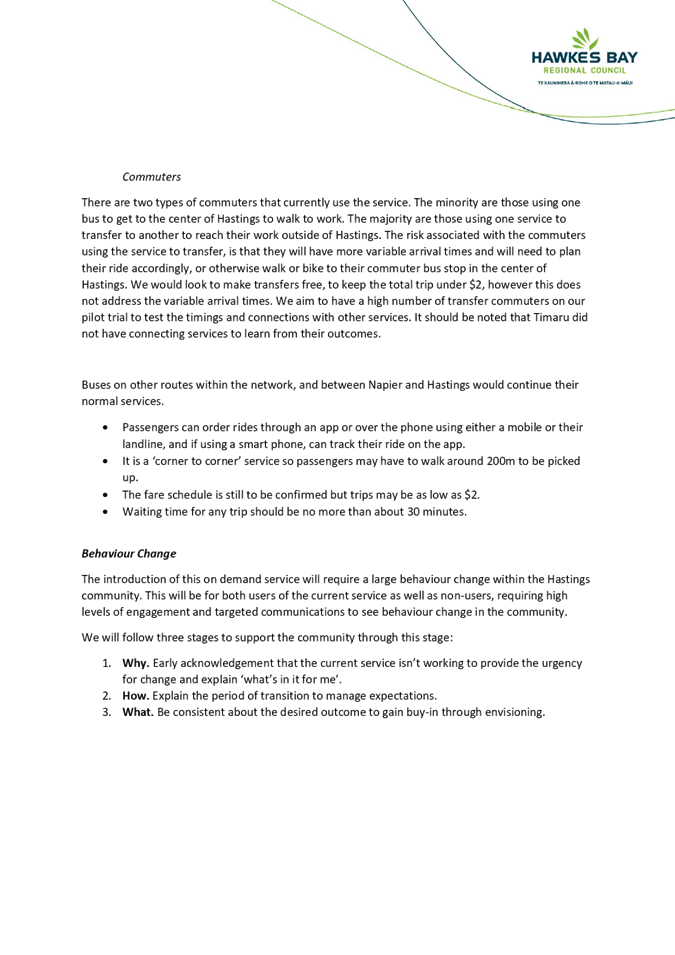
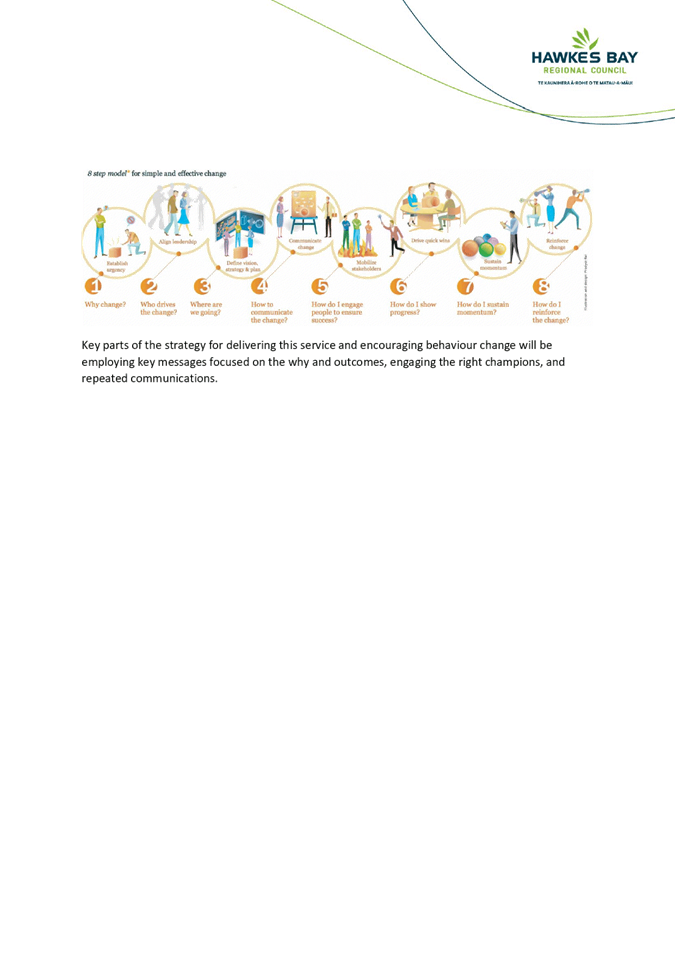
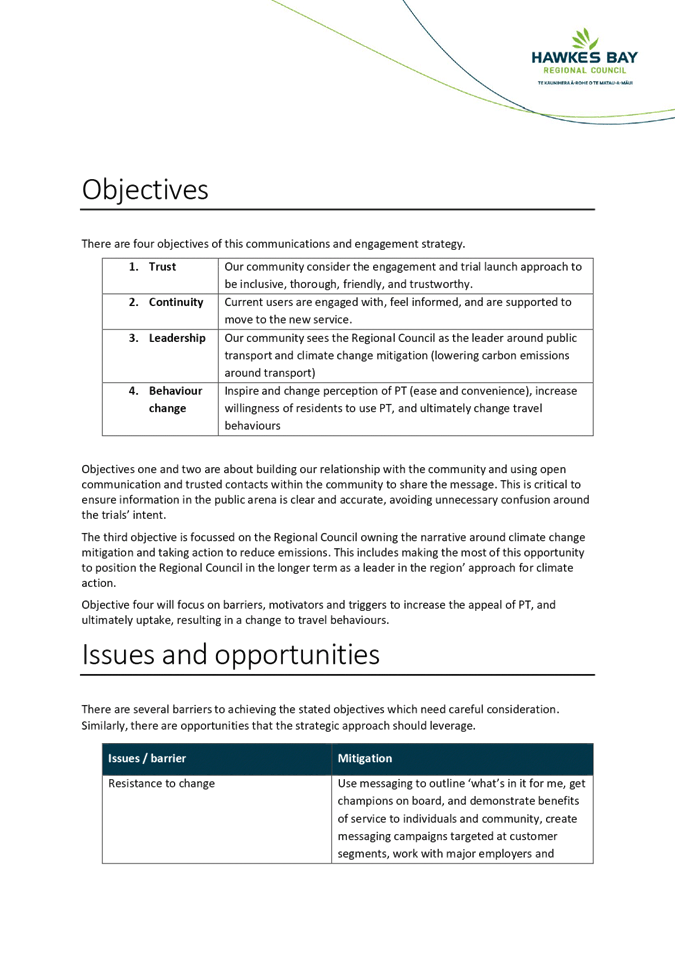


HAWKE’S BAY REGIONAL COUNCIL
Regional
Transport Committee
11 March
2022
Subject: March 2022 Public Transport
Update
Reason
for Report
1. This item provides the
Committee with an update on Council’s public transport operations.
Background
2. The responsibility for
contracting public transport services is assigned to regional councils under
the Land Transport Management Act 2003. Under Section 35, the council
must consider the needs of the “transport disadvantaged” when
preparing its Regional Public Transport Plan (RPTP), which sets out the
services that the council will provide.
3. “Transport
disadvantaged” means people who the regional council has reasonable
grounds to believe are the least able to travel to basic community activities
and services (for example work, education, healthcare, welfare, and
shopping). As part of the responsibility to the transport disadvantaged,
councils also provide Total Mobility services where suitable transport
operators exist to deliver the service.
On-demand Public Transport Trial (also commonly known as DRT
– Demand Responsive Transport)
4. With LTP and
Waka Kotahi funding now approved, the project management team, including a
representative of Hastings District Council, is working towards a trial start
date of 6 June 2022.
5. An engagement
plan has been developed outlining how we will undertake consultation with the
wider community to understand their passenger transport needs, barriers and
what incentives we can use to entice them to use the on-demand service.
6. Branding,
service area, and payment provisions are now finalised. Details such as fares,
wait times, and walking distances are discussed in a separate report in this
agenda.
COVID-19
7. All buses have COVID tracer
app QR posters displayed at the doors and onboard in several places. Our online
trip register is also available, via the goBay website, for passengers who
don’t have smartphones.
8. Face coverings on public
transport are now mandatory for all passengers including students in Year 4 and
above. Compliance in adults is generally good, however this is not the case
with high school students. The transport team have been in touch with some high
schools requesting that they remind students of the rules.
9. We have been advised by our
service provider, Go Bus Transport Ltd, that following a risk assessment, they
do not intend to mandate vaccinations for bus drivers at this time.
10. Go Bus Transport Ltd has
registered for the critical workers exemption scheme, which will entitle them
to a free supply of RATs (rapid antigen tests) for bus drivers.
Reduced Timetable
11. On Thursday 10 February we
were advised by Go Bus Transport Ltd that severe labour shortages meant that
they were unable to operate the full timetable without high numbers of trip
cancellations. The decision was made to move to a Saturday PLUS timetable from
Monday 14 February until further notice. This reduced timetable includes
Saturday services, plus Routes 10, 11, 16A, 16, 17, our two contracted school
services (Taikura Rudolf Steiner and Hastings Boys’ High School) and some
other peak time services.
12. This has been communicated
to the public via on-bus messaging, radio ads, community newspapers, the HBRC
and goBay websites and Facebook pages. The Customer Experience and transport
teams are dealing with an increased volume of enquiries from the public due to
these changes.
13. This timetable will be in
operation until further notice and until Go Bus Transport has been able to fill
bus driver vacancies. (It should be noted that we are one of several regions
also experiencing labour shortages resulting in reduced timetables.)
14. The latest update has this
likely extending to the end of March 2022.
Network Review
15. A network review is
currently underway as part of the preparation for the Regional Public Transport
Plan. The review is being undertaken by MRCagney and is due for completion in
March, with the following plan to be completed in May.
Passenger Survey 2022
16. Due to the reduced
timetable, the passenger survey, which was scheduled for early March, has been
postponed until further notice.
Public Transport Service Trips
17. Diagram 1 (attached) shows
public transport trips made from July 2012 to January 2022.
18. It should be noted that
there were no trip statistics for July and August 2020 as the crossover in
ticketing systems saw the buses operating without ticketing equipment.
Public
Transport Service Costs
19. Diagram 2 (attached) shows
the year-to-date net cost (after fares and excluding GST) of operating the
goBay bus service from July 2012 to January 2022.
20. Cost increases are largely
due to inflationary pressure (as our bus contract is adjusted by an NZTA index
reflecting fuel, labour, and infrastructure prices), lower fare revenue due to
a new low flat fare schedule, the cost of paid breaks added to the driver hours
as required by the Employment Relations Amendment Act and payment of the living
wage to bus drivers.
Total
Mobility Scheme
21. The Total Mobility Scheme
provides subsidised taxi travel for Hawke’s Bay residents who are unable
to use public transport due to a significant, permanent impairment. People
assessed for and registered to the scheme receive taxi vouchers entitling them
to a 50% fare discount (some restrictions apply). The scheme is administered by
the Regional Council and funded by both the Council and Waka Kotahi.
Ridewise
22. The implementation of
Ridewise is underway, with the first stage to be complete in the first two
weeks of March. Ridewise is scheduled to be fully operational by late April or
early May.
23. HBRC is currently cleansing
data and working with Transport Operators to ensure they have compatible
technology.
24. Once Ridewise is
implemented, the process will experience increased automation, and will be
managed predominantly by exception.
Total
Mobility Scheme Trips
25. Diagram 3 (attached) shows
the number of Total Mobility trips made from July 2012 to January 2022.
Total
Mobility Scheme Cost
26 Diagram 4 (attached) shows
the cost of the Total Mobility Scheme (excluding GST) from July 2012 to January
2022.
Decision Making Process
27 Staff have assessed the requirements
of the Local Government Act 2002 in relation to this item and have concluded
that, as this report is for information only, the decision-making provisions do
not apply.
Recommendation
That
the Regional Transport Committee receives and notes the “March 2022
Public Transport Update” report.
Authored by:
|
Megan Welsby
Sustainable Transport Advisor
|
|
Approved by:
|
Katie Nimon
Transport Manager
|
|
Attachment/s
|
1⇩
|
Public Transport Service Trips and
Costs
|
|
|
|
2⇩
|
Total Mobility Scheme Trips and
Costs
|
|
|
|
Public Transport Service Trips and Costs
|
Attachment
1
|
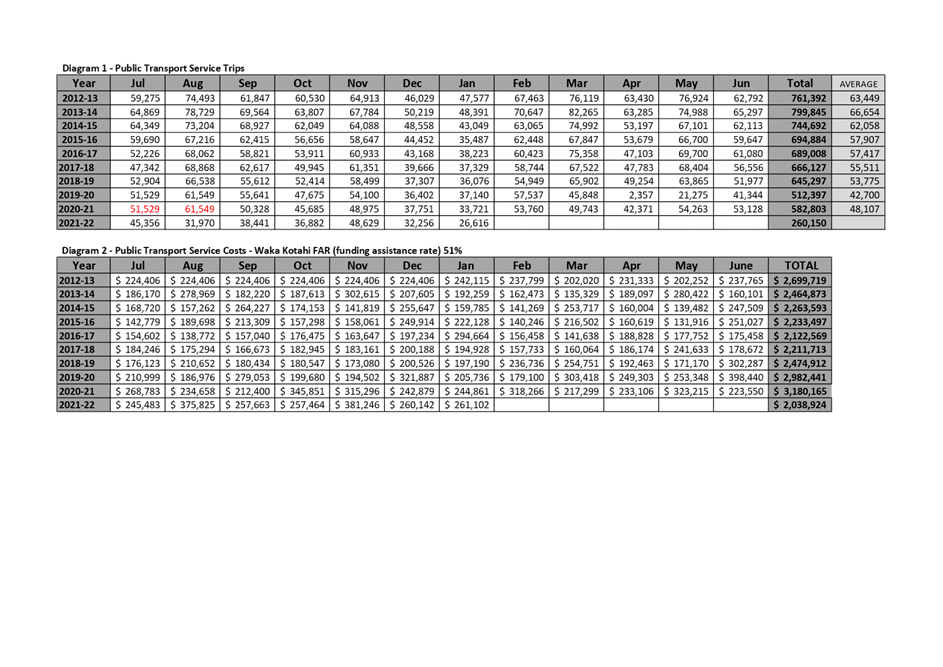
|
Total Mobility Scheme Trips and Costs
|
Attachment
2
|
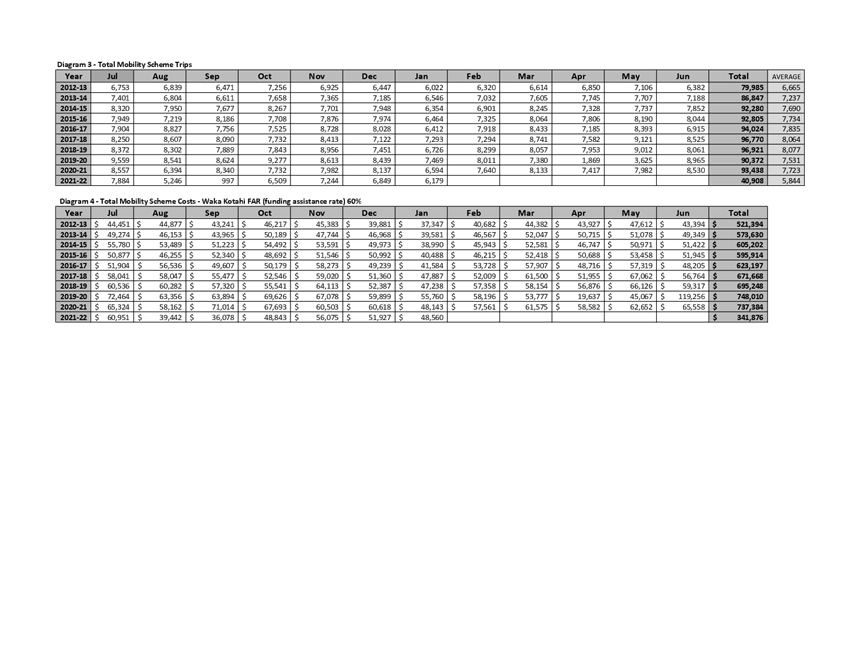
HAWKE’S
BAY REGIONAL COUNCIL
Regional
Transport Committee
11 March
2022
Subject: Roadsafe Update
Reason for Report
1. This regular report
provides the Committee with an update on road safety statistics in the region
and road safety activities undertaken by Road Safe Hawke’s Bay.
Background/Discussion
2. There are three significant documents
that provide the direction for the road safety activities, including:
2.1. The Government Policy Statement for
Land Transport (GPS)
2.2. “Road to Zero “– the
NZ road safety strategy 2020
2.3. The Hawke’s Bay Regional Land
Transport Plan.
3. The current Regional Land Transport
Plan (RLTP) addresses road safety and includes several strategic objectives and
policies directed at reducing deaths and serious injuries. The RLTP also
includes specific targets to reduce deaths and serious injuries aligning with
the national Road to Zero strategy.
4. The Road Safe Hawke’s Bay
programme addresses road user choices and activities
focus on the high-risk road safety for the region and includes the following
projects over the next three months:
4.1. Ongoing delivery of Youth/Rangitahi
project presentations, in partnership with NZ Police and employment providers
4.2. Operation Crest has run during
February focussing region wide on return to school travel, car seats, adult
seatbelts, distraction, and speed
4.3. Supporting the ACC initiative
‘Shiny Side Up’ Motorcycle event promoting the Ride Forever
motorcycle training programme
4.4. Youth Road Safety social media
campaign, which would have otherwise been delivered in person at the Expo in
May. This campaign will target risk associated with young drivers.
Hawke’s Bay Statistics
5. Road death and serious injury (DSI)
statistics are reported by the NZTA with data to the end of September, shown
below.
6. The number of road deaths so far this
year is 8, with 2 recorded for Hawke’s Bay in quarter 2 of the 2021-2022
financial year.
7. The total number of DSI for Q2 is 58,
with 56 being serious injuries.
8. This equates to 31.9 DSI per 100,000
population.
|
DSIs by quarter per 100,000 population in Hawkes Bay
Region
|
|
Quarter
|
Date Covered
|
Population in
Hawke’s Bay
|
Deaths
|
Serious injuries
|
Total number of DSIs
|
DSIs per 100,000
population
|
|
Q2
|
01/10/2021
-31/12/2021
|
181,500
|
2
|
56
|
58
|
31.955
|
|
Q1
|
01/7/2021 – 30/09/2021
|
181,500
|
0
|
24
|
24
|
13.223
|
|
Q4
|
01/04/2021 –
30/06/2021
|
181,500
|
3
|
19
|
22
|
12.121
|
|
Q3
|
01/01/2021 –
31/03/2021
|
181,500
|
3
|
41
|
44
|
24.242
|
|
Full year
|
01/01/2021 -
31/12/2021
|
181,500
|
8
|
140
|
148
|
81.542
|
S17a Review
9. All stakeholders have had the opportunity
to provide feedback.
10. Based on feedback, a matrix has been
established to calculate the best possible outcomes for Road Safety delivery.
Stakeholders at the workshop challenged the values attributed to some of the
points in the matrix, which was discussed and finalised.
11. It is agreed that:
11.1. Leadership should come from the RTC,
and all expectations should be clarified
11.2. The approach should be holistic
(safety, social, and economic) and focussed on a ‘safe system’
11.3. Delivery should be approached
regionally, with the right people in the right place
11.4. The programme needs to be linked to
the infrastructure programme as well as the Waka Kotahi programme, with focus
on what message and why, and then where and how to deliver it.
12. There is an interest in working more
closely with surrounding regions (Horizons and Tairawhiti) given we share state
highways.
2022 Road Safety Expo
13. Due to event restrictions, and general
uncertainty around organising events, HBRC have decided not to run the 2022
Road Safety Expo. Instead, HBRC has engaged MarComms to begin working on a
communication plan to reach the audience digitally.
14. This is a good opportunity to
investigate the success of road safety messaging through social media and will
help us reach a targeted demographic that is most at risk. As a captive
and engaged audience, in a way they are comfortable receiving information.
15. The stakeholders and committee members
have been advised.
16. Over 2000 Hawke’s Bay students
would normally attend the expo across the week.
17. Stalls, activities, and displays would
include: DHB (Trauma), DHB (Drug and Alcohol), St John (First Aid), FENZ, ACC,
Dunstall’s Funeral Services, Brain Injury HB, Helen Small (Personal
Story), Police (Booze Bus), Police (Driver Licensing), Police (Crash), Police
(Speed), RoadSafe HB (UCSR and ANCAP vehicle safety), RoadSafe HB (SOBAD),
RoadSafe HB (Party Register), RoadSafe HB (Distracted Driving), RoadSafe HB
(Driver Impairment).
18. The social media campaign will pull
together and deliver road safety messaging from all stakeholders.
19. Feedback from students indicated that
they’d like more time to participate in activities at the expo and would
like more hands-on activities. This feedback will be taken into consideration
when planning the social media campaign. While hands-on activities are
unlikely, thought can be given to how the campaign can be interactive and
participatory rather than passive.
Decision Making Process
25 Staff have assessed the requirements
of the Local Government Act 2002 in relation to this item and have concluded
that, as this report is for information only, the decision-making provisions do
not apply.
|
Recommendation
That
the Regional Transport Committee receives and considers the “Roadsafe Update” staff report.
|
Authored by:
|
Liz Schlierike
Roadsafe Coordinator
|
Katie Nimon
Transport Manager
|
Approved by:
|
Katrina Brunton
Group Manager Policy &
Regulation
|
|
Attachment/s
There are no attachments for this
report.
HAWKE’S
BAY REGIONAL COUNCIL
Regional
Transport Committee
11 March
2022
Subject: Transport Manager’s
March 2022 Report
Reason for Report
1. This report provides the
Committee with a snapshot of relevant transport matters, provides updates from
the Transport Advisory Group (TAG) on issues raised at their regular meetings
and outlines what is coming up within the Transport sector.
Executive Summary
2. This report provides a
summary of current national and local issues and work programmes from Waka
Kotahi, Ministry for the Environment and Ministry of Education, the Passenger
Transport Network/Service Review, Regional Cycling Governance Group, Regional
Cycle Plan, On Demand Public Transport, Ridewise, Roadsafe, Driver Licensing
Programme, and work programmes from the Transport Special Interest Group
(TSIG).
3. Separate reports to this
meeting cover the On Demand Public Transport Trial, Regional Cycling
Governance, a Road Safety update, and the Public Transport service delivery.
Discussion
Network/Service Review & Regional
Public Transport Plan (RPTP)
4. The network review is
underway and due to be completed mid-March. The network plan will commence in
the first week of March with a completion date of mid-May. MRCagney are working
with multiple levels of data including current public transport statistics,
population growth, district plans, and national policy.
5. Work will soon begin on the
RPTP in conjunction with the review and plan, with the document to be finalized
in June.
6. The RPTP should have been
completed within six months of the adoption of the RLTP however the delay, due
to Covid-19 and staffing issues, has been raised with Waka Kotahi.
Regional
Cycling Governance Group (RCGG)
7. This group was established
to govern the Hawke’s Bay Trails under the Great Ride scheme, however, is
now more focused on the overall regional cycle network. As a result, there is
little connection to the Regional Transport Committee (RTC). Active Transport
is now a key mode focus as part of the overall Transport picture, and as such,
should be governed in the same way as public transport, total mobility,
freight, engineering, and road safety.
8. A discussion document with
officer recommendations is included in this agenda.
9. At the last meeting of the
RCGG on 14 February, concerns were raised by members that cycling will not
receive appropriate attention under the proposed structure. This will be
addressed in the discussion document.
Hawke’s
Bay Regional Cycle Plan (RCP)
10. The RCP has been drafted by
the RCGG but has not been presented to the RTC for endorsement.
11. Active transport is a key
feature of a multi modal public transport network, and as such, the RCP should
be finalized in conjunction with the RPTP engagement process and presented to
the RTC together.
On
Demand Public Transport (ODPT)
12. This project is currently
on track and on budget. However, there are risks involved in the delivery
dates, as it is reliant on external parties, such as the procurement and fit
out of fleet, and procurement of technical equipment. Both are fundamental to
the delivery of the service, and due to international shipping issues, we are
expecting lengthened delivery times. We have mitigated the risk of delay by
procuring a variety of fleet types and have been able to secure technical
equipment from other regions’ existing stock. Further details of the ODPT
trial have been outlined in the On Demand Public Transport update.
Ridewise
13. The first migration of data
to the Ridewise system has been completed, with very few issues found. There is
a small amount of further cleansing required, before the system can be used as
an internal database. The organization has contracted an external project
manager to manage the process. This project manager has managed implementation
the Ridewise system for all other regions.
14. Transport Operators are
supportive of the system and are currently working with HBRC on implementation.
Further details will be outlined in the Public Transport update.
RoadSafe
15. We are still operating the
RoadSafe programme with 1.2 FTE, as opposed to 1.75, which is continuing to
place pressure on the delivery capacity and reduces our ability to be reactive
to community opportunities.
16. The Road Safety Expo 2022
has been cancelled due to Omicron and its associated event restrictions. HBRC
has committed to delivering the messaging through a social media campaign,
targeting the audience that would otherwise attend the expo. Work has begun on
a comms plan, and the campaign will run in May, when the Expo would have been
scheduled.
17. The s17a review has been
completed by Morrison Low and the findings and proposed outcome presented to
the RTC in a separate item on today’s agenda.
Driver
Licensing Programme
18. Contract variations have
been signed by programme providers, and delivery will continue to the end of
the financial year.
19. The contract variations
included additional reporting requirements to align with the Vision Zero
strategy.
20. Wairoa has now secured a
local instructor, which will support the delivery of the programme operated by
Wairoa College.
21. We are continuing to look
at methods and opportunities for funding of businesses that mentor and license
drivers to ensure that the funding removes the cost barrier. Providers in
Central Hawke’s Bay are doing well in this area already.
22. HBRC and Waka Kotahi have
discussed the future of the driver licensing programme and agree that our
regions’ high number of adult learners and restricted license holders
should be addressed. This is a growing number and could be considered for the
future driver licensing programme funded by Waka Kotahi and HBRC.
Public
Transport Operating Model (PTOM) Review
23. The Ministry of Transport
have provided an update on the PTOM review.
24. The PTOM is likely to be
replaced by “The Sustainable PT Framework” which focuses on mode
shift, a sustainable labour market, environmental and health outcomes, and
value for money and efficiency.
25. It will likely no longer be
focused on commerciality, reducing reliance on subsidies, and competitive
tendering.
26. The model will be managed
by a procurement manual and guidelines, which will be developed by a working
group with representatives from large, medium, and small regional councils. The
working group will be established this quarter.
27. The Sustainable PT
Framework will likely include a zero emission buses mandate.
28. The Ministry of Transport
is looking to increase transparency of operator costs and financial
performance, which will likely result in the ability to negotiate rather than
competitively tender. The associated legislative process will commence in
approximately 12 months.
Road
User Charges Consultation
29. The Ministry of Transport
has advised that they are seeking feedback on possible changes to the Road User
Charges (RUC).
30. They are considering how
RUC might be used to charge for greenhouse gas emissions and other factors such
as noise pollution and congestion. Currently RUC predominantly contributes to
road damage costs.
31. They are also considering
removing paper label requirements and mandating electronic RUC for heavy
vehicles. This can come at a cost of approximately $70 per vehicle per month,
which is cost prohibitive for some companies. Ia Ara Aotearoa Transporting New
Zealand (formerly the Road Transport Forum) is submitting feedback to the
Ministry of Transport in this regard.
32. HBRC is aware that any
increase in cost or requirements for heavy vehicle operators often results in
adverse consequences, such as lower productivity and increased cost to the
region. HBRC is also aware that national funding for transport is
limited, and RUC is way to address this.
33. If the RTC was to submit
feedback to the Ministry, it would be challenging to separate the climate and
funding benefits from the cost and productivity implications.
Emissions
Reduction Plan
34. MfE has released NZ’s
first Emissions Reduction Plan as required under the Climate Change Response
Act 2002. The Transport Special Interest Group (TSIG) has sent a submission on
the document, only commenting on the Transport section of the plan. HBRC has
contributed to this, and the submission was supplied to the RTC at the December
meeting.
35. The RLTP contains vision
and objectives aimed at reducing transport emissions through increased use of
public and active transport, increased use of rail for freight and integrated
land use planning that reduces reliance on private vehicles. The newly
developed ERP presents an opportunity to get strong national alignment and
allow “the changing of hearts and minds” to be influenced at a
Central Government level. Our focus must now be on alignment and integration of
district and regional planning to ensure targets are met was a region.
36. It is agreed that a 20%
reduction in vehicle kilometers traveled (VKT) requires a mode shift to PT and
active modes.
37. Waka Kotahi is currently
reviewing the Investment Decision Making Framework (IDMF) to better consider
climate change.
Travel
Demand Management (TDM)
38. The TSIG has established a
TDM working group, which HBRC has representation. Work is already underway to
find examples of best practice internationally and success stories in the
public engagement space. As with the submission on the ERP, the focus of this
group is ASI. The TDM group is also very aware of the different issues
presented within the regions, such as a lack of congestion and motivation to
seek a shift in modes, given that for many of the Territorial Authorities,
parking is a priority. Integrated spatial planning plays a role in this, as
does education and engagement.
39. The current student
movement for free fares for anyone under 25, is collectively believed to not
support Mode Shift. The movement was about social good rather than transport
outcomes, and most regions would see around a 30% reduction in their fare
revenue. Ultimately, if under-25s can travel for free, it’s believed that
those that might have traditionally walked or cycled will take public transport
for shorter trips instead of getting those that might have otherwise travelled
by car to travel by bus. Some regions are opting to review their fare policies
rather than react to the free fares movement because of this.
Ministry
of Education School Bus Network
40. The new 12-year contract
for school bus services began at the end of January, with some disruption
around the country and wider Hawke’s Bay Region. HBRC has not seen an
influx in public transport use because of any changes. There is a possibility
that drivers changing operators during this time has impacted the driver
shortage issue we face with our PT operator.
Regional Land Transport Plan
(RLTP) Investment & Delivery Issues
41. The Technical Advisory
Group meeting held on 14 February 2022 was largely dedicated to a challenge
workshop for the s17a Road Safe review. Roading authorities were asked to
submit any issues or delays via email, and none were received. HBRC considers
that Wairoa, CHBDC, NCC and Hastings District Council all indicated their work
programmes were on track.
Judicial review of the 2021-24 National Land Transport Plan (NLTP)
42. A judicial review has been brought
against Waka Kotahi by transport advocacy organsiation, Movement, on the
adoption of the 2021-24 NLTP. Movement claims the NLTP's adoption was unlawful
because of the way Waka Kotahi considered greenhouse gas emissions in their
decision-making – and as a result failed to give effect to the climate
priorities in the Government Policy Statement for land transport (GPS).
43. Waka Kotahi is defending the claim.
They believe the process in developing and adopting the 2021-24 NLTP was
lawful, robust and that the programme gives effect to all four priorities
within the GPS, as well as the Government’s commitments.
44. Waka Kotahi recently shared the claim
information with Approved Organisations – as it could have an impact on
the funding and delivery of the current land transport programme.
45. If Movement’s claim is
successful, the 2021-24 NLTP will be declared void and Waka Kotahi will need to
review and redevelop the 2021-24 NLTP. That means many of the activities would
have to be reconsidered and may be reprioritised, including those that have
already been approved for funding.
46. The High Court has given all Approved
Organisations the opportunity to participate in the claim because of the
potential impacts on work programmes. Waka Kotahi has been in touch to
discuss the judicial review and HBRC’s potential involvement.
47. HBRC has until 14 March to inform the
Court if they would like to participate.
Decision Making Process
48. Staff have assessed the
requirements of the Local Government Act 2002 in relation to this item and have
concluded that, as this report is for information only, the decision-making
provisions do not apply.
|
Recommendations
That
the Regional Transport Committee receives and considers the “Transport Manager’s March 2022 Report”.
|
Authored by:
|
Katie Nimon
Transport Manager
|
|
Approved by:
|
Katrina Brunton
Group Manager Policy &
Regulation
|
|
Attachment/s
There are no attachments for this
report.
HAWKE’S
BAY REGIONAL COUNCIL
Regional
Transport Committee
11 March
2022
Subject: Waka Kotahi Central Region -
Regional Relationships Director's March 2022 Report
Reason for Report
1. This item introduces the
Waka Kotahi NZTA Central Region Regional Relationships Director’s
report.
Decision Making Process
2. Staff have assessed the requirements
of the Local Government Act 2002 in relation to this item and have concluded
that, as this report is for information only, the decision-making provisions do
not apply.
|
Recommendation
That the Regional Transport
Committee receives and notes the “Waka Kotahi Central Region – Regional
Relationships Director’s March 2022 Report”.
|
Authored & Approved by:
|
Linda Stewart
Waka
Kotahi
Central Region – Regional
Relationships Director
|
|
Attachment/s
|
1⇩
|
Hawke's Bay Regional Update - March
2022
|
|
|
|
2⇩
|
Waka Kotahi March 2022 Presentation
|
|
|
|
Hawke's Bay Regional Update - March 2022
|
Attachment
1
|
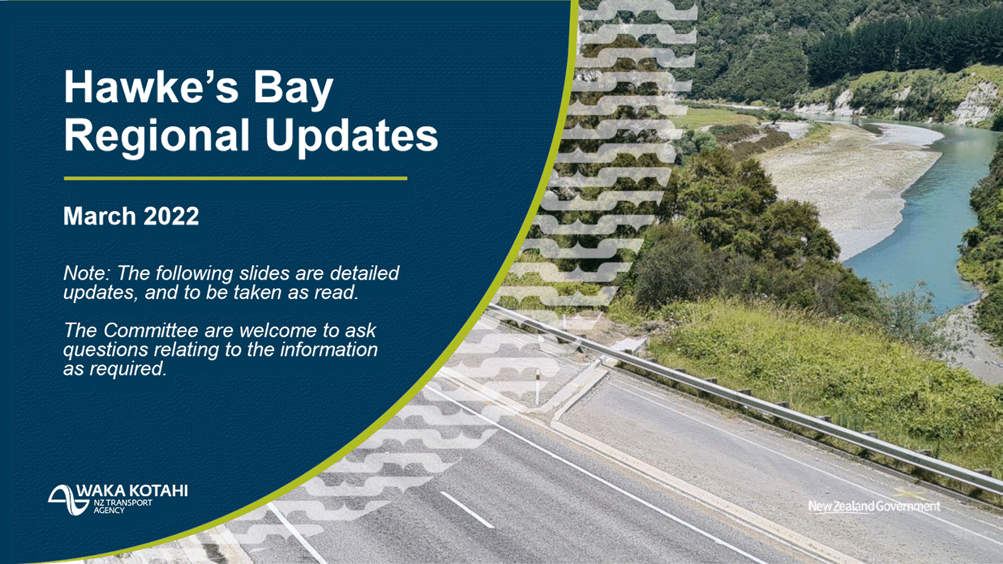
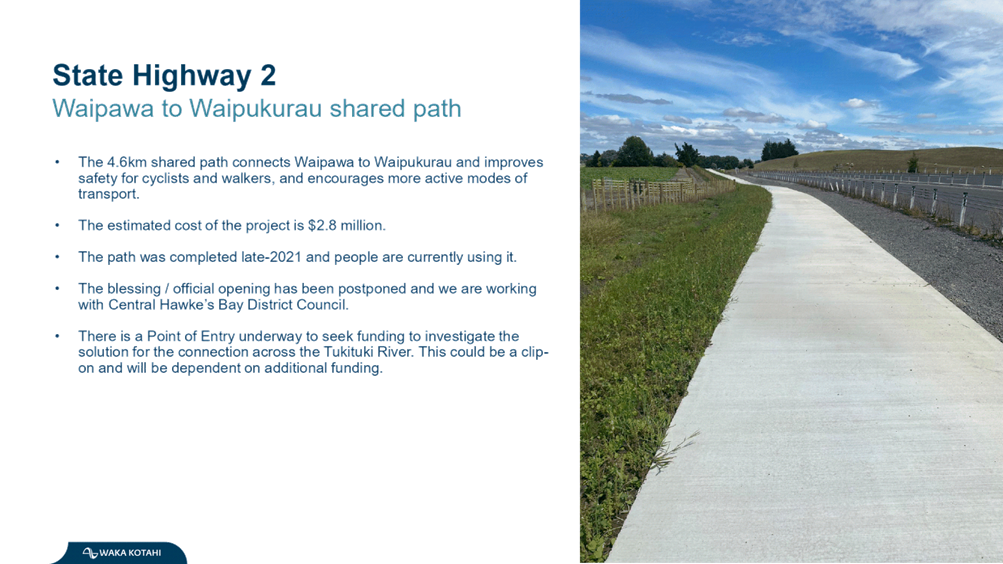

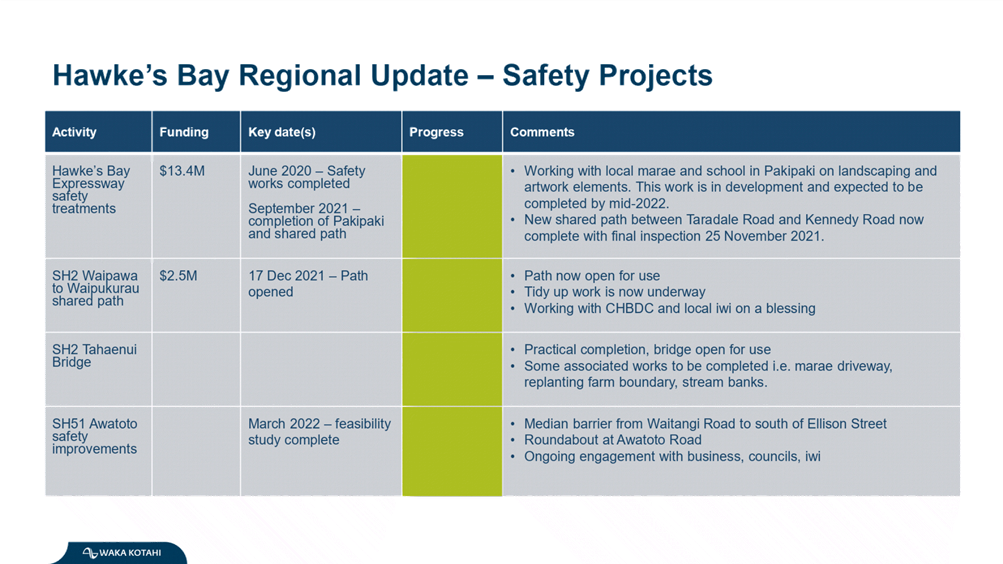
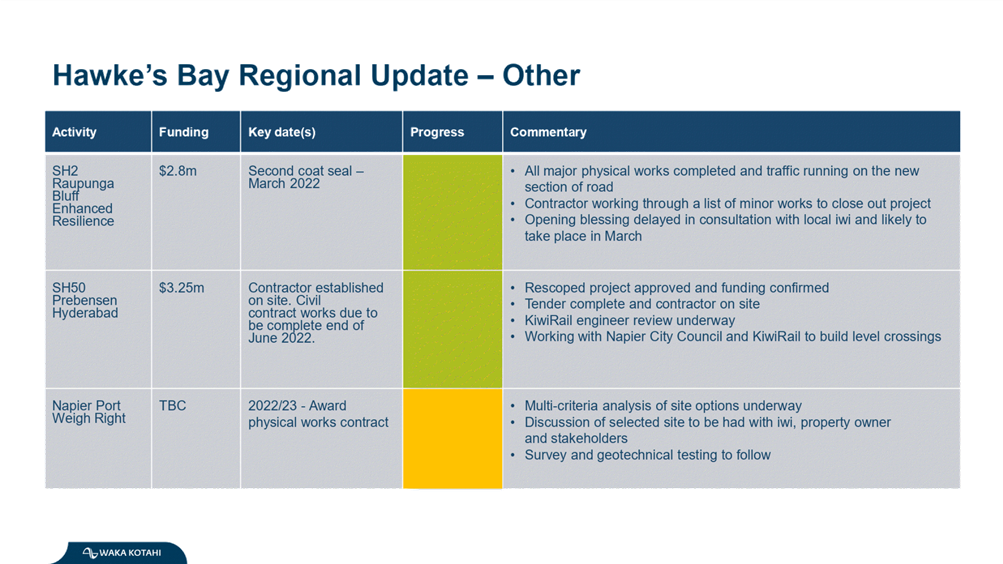
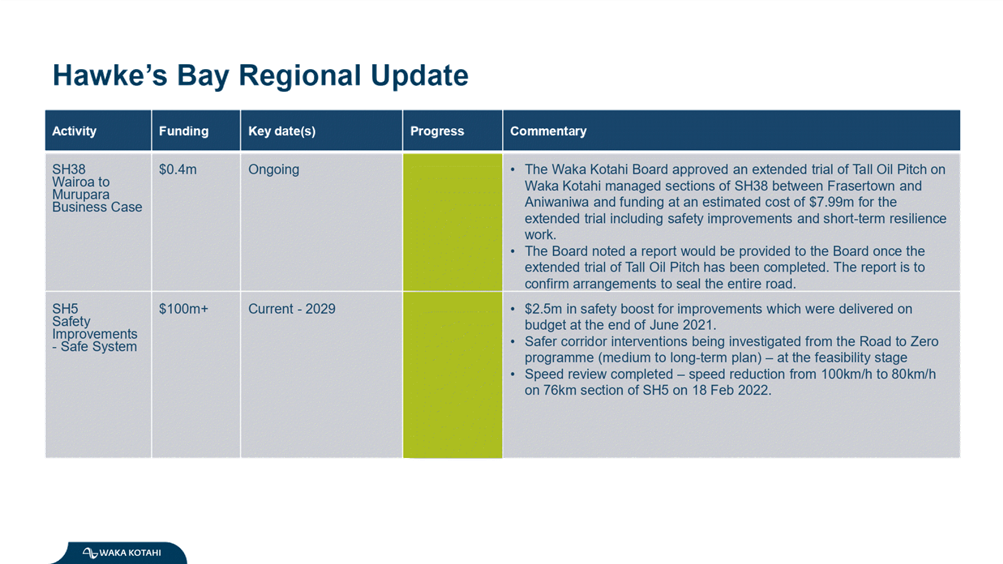
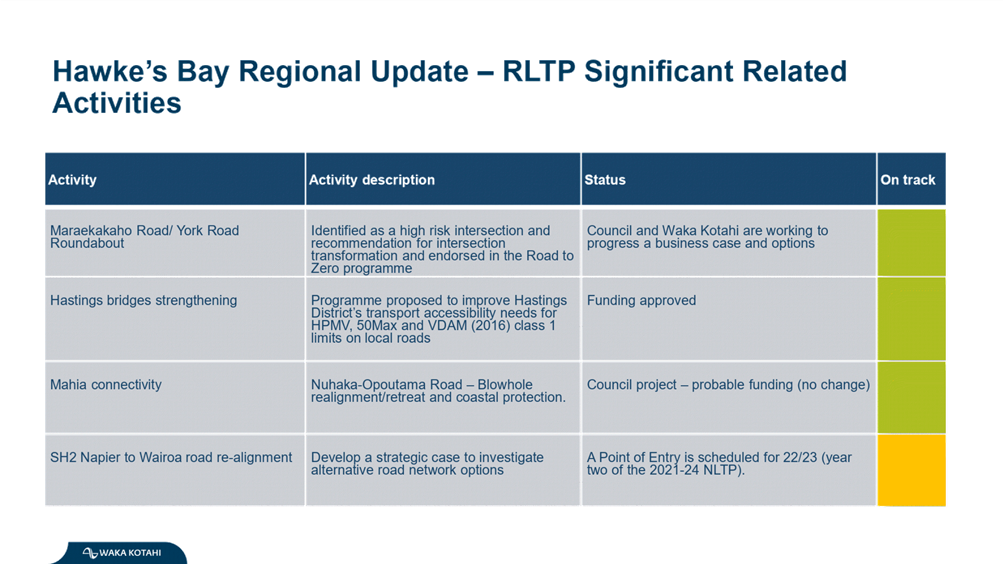
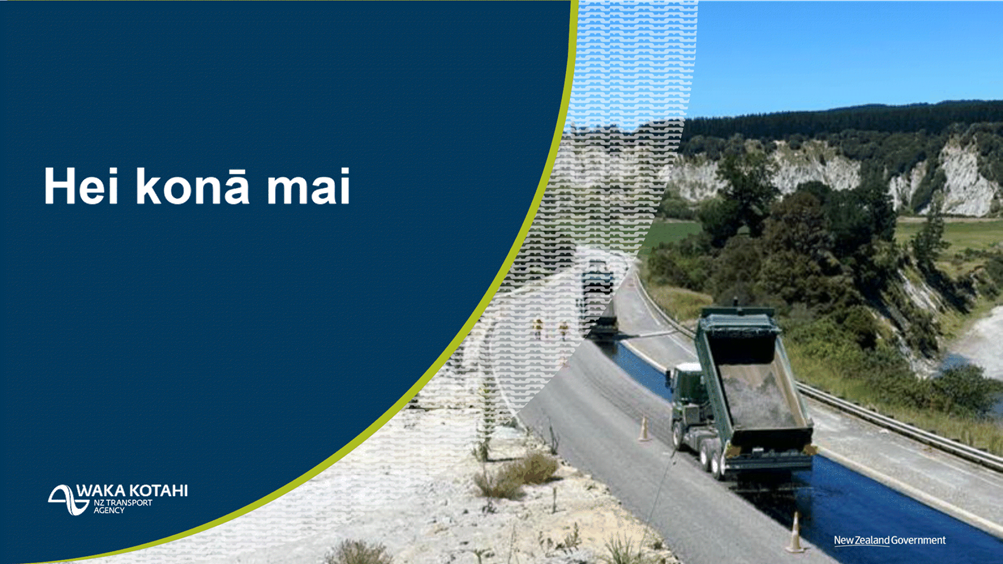
|
Waka Kotahi March 2022 Presentation
|
Attachment
2
|
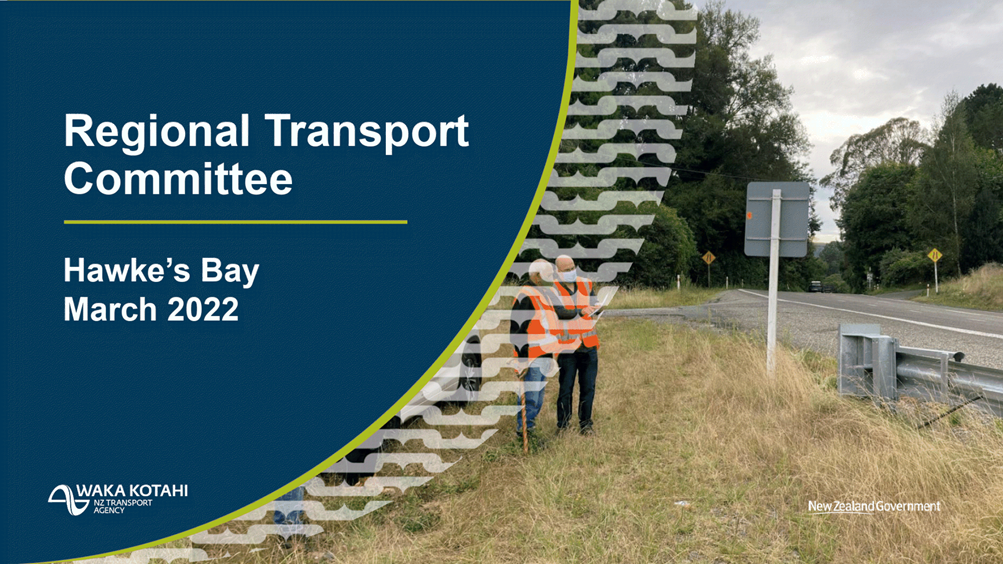
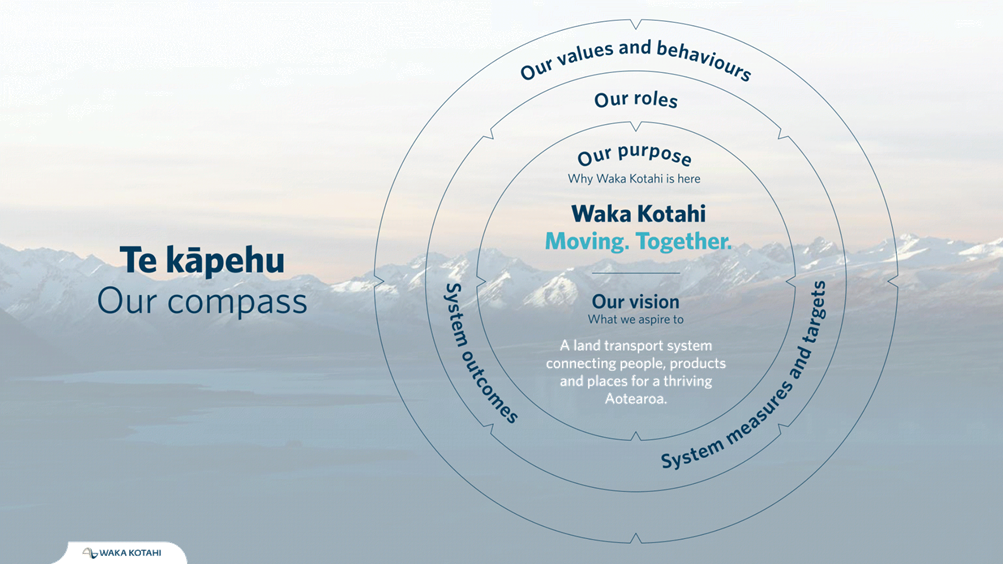
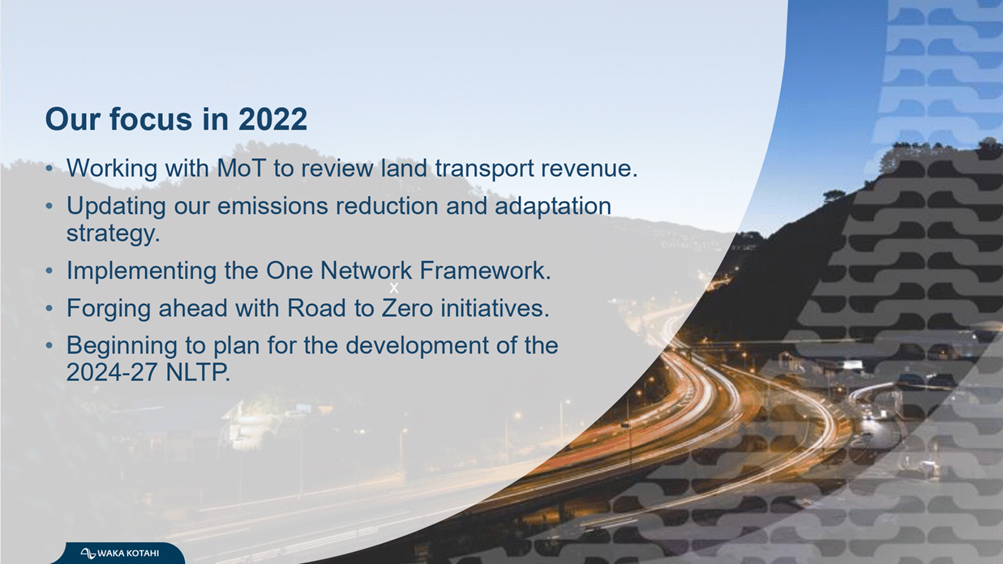
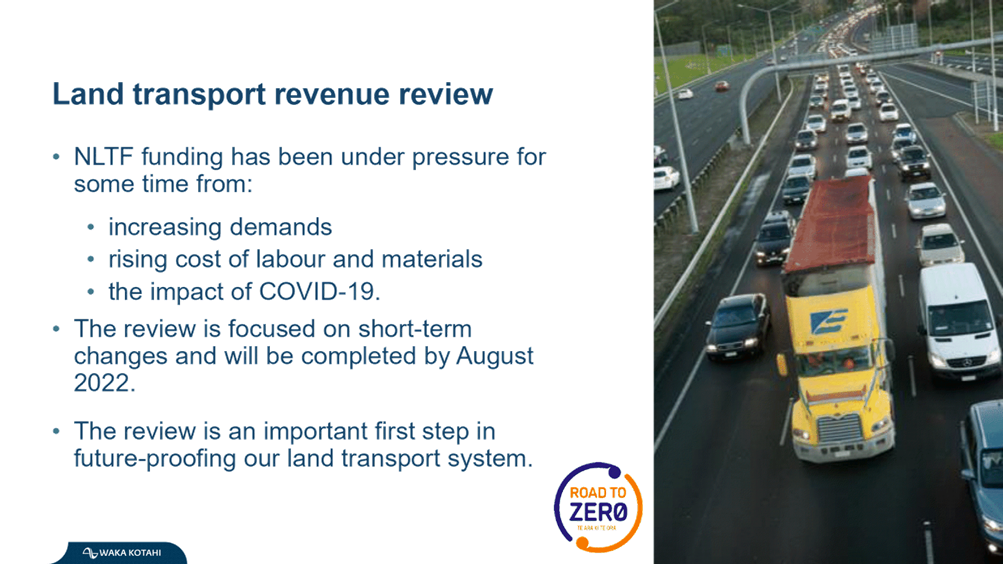
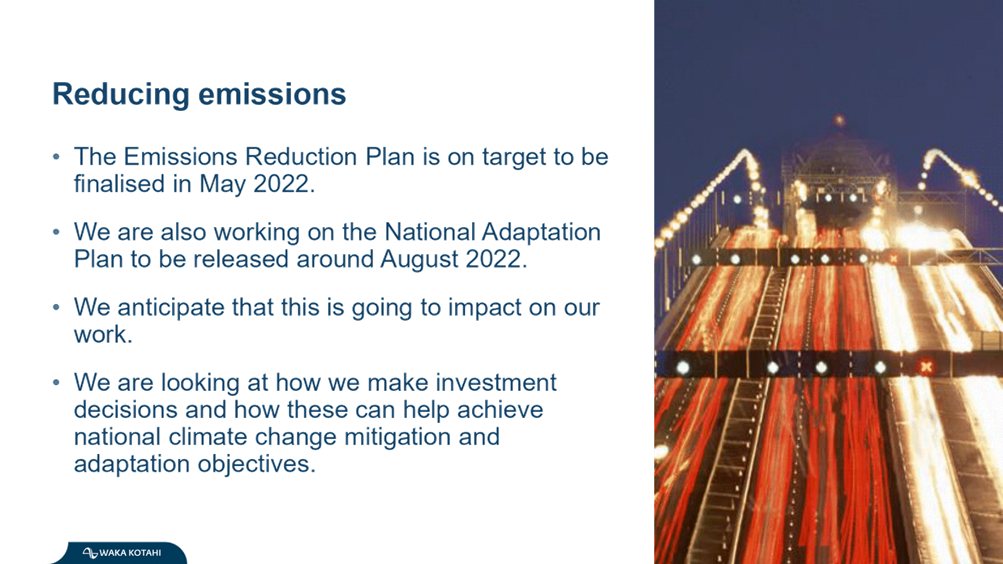
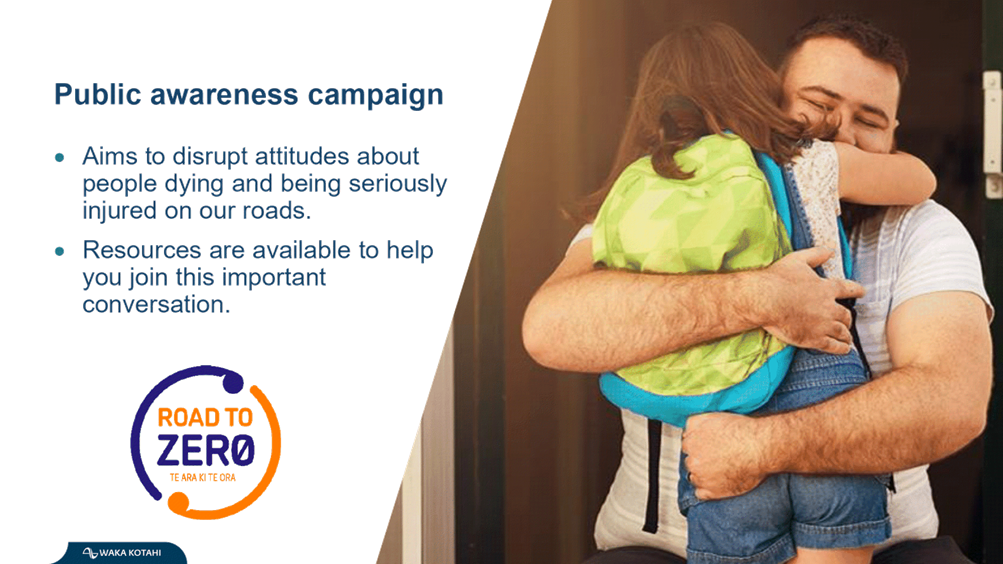
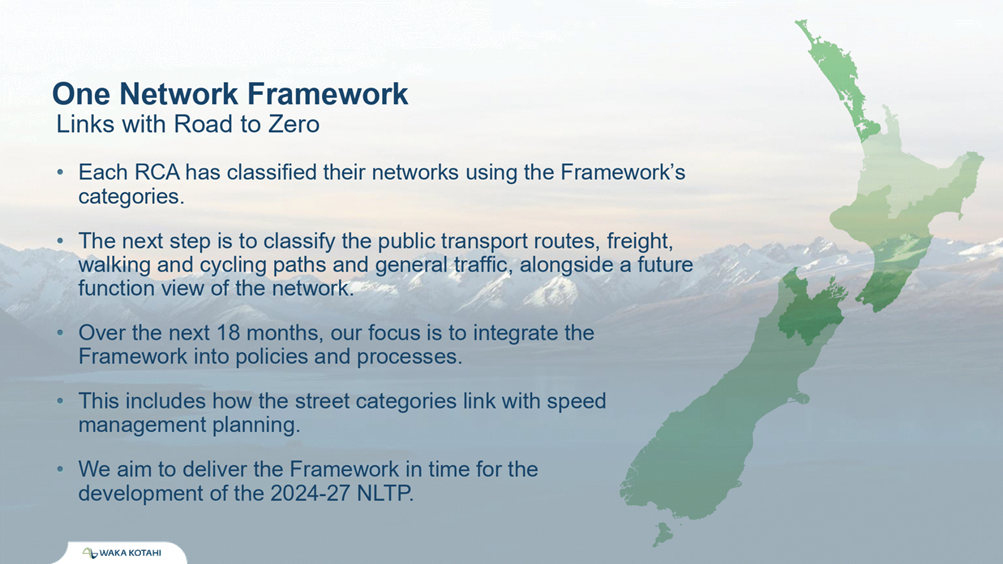
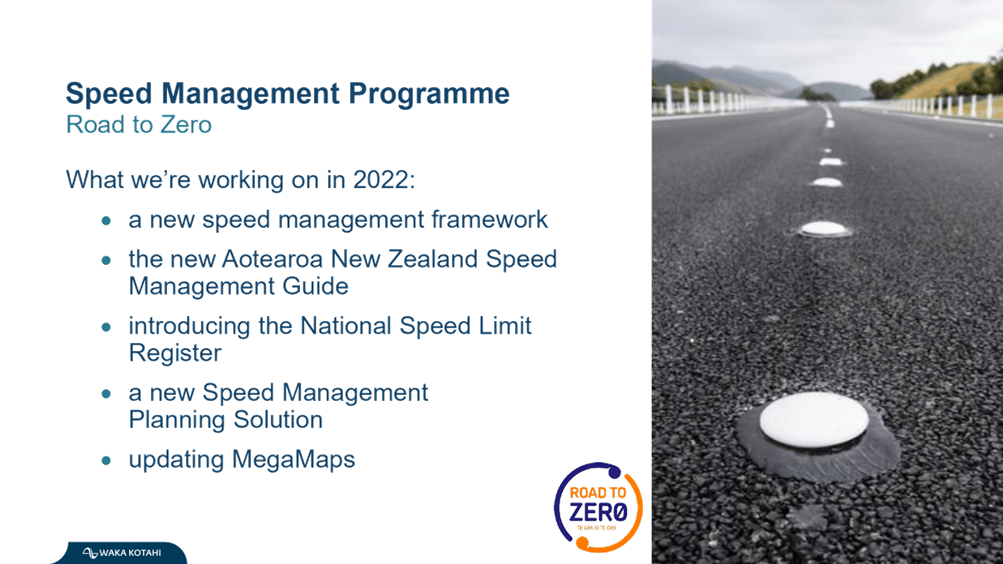
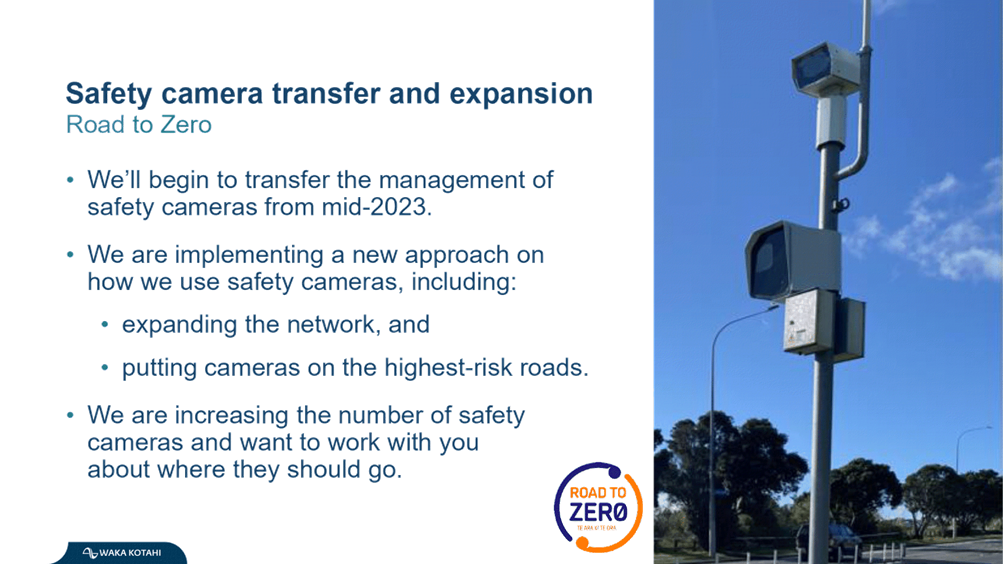
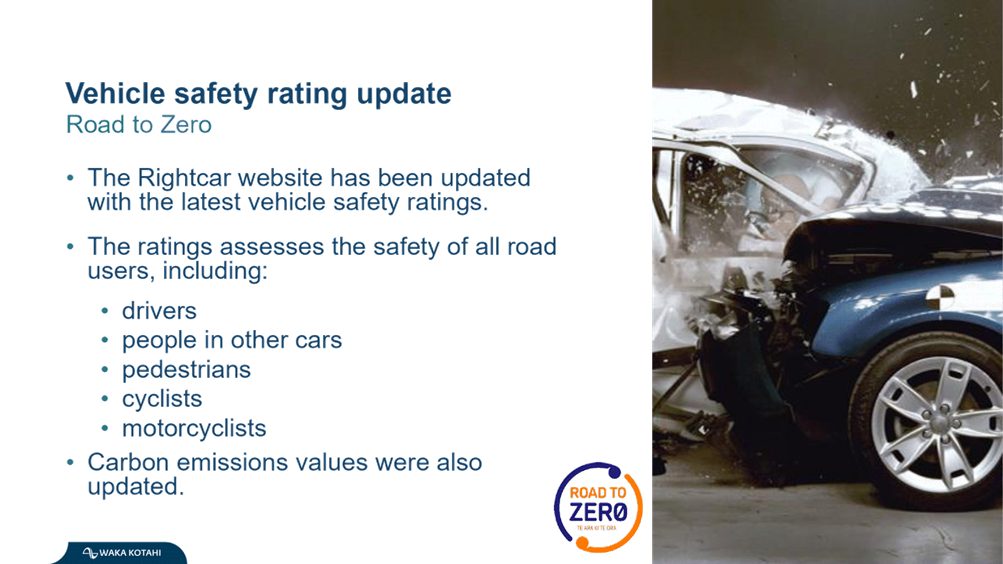
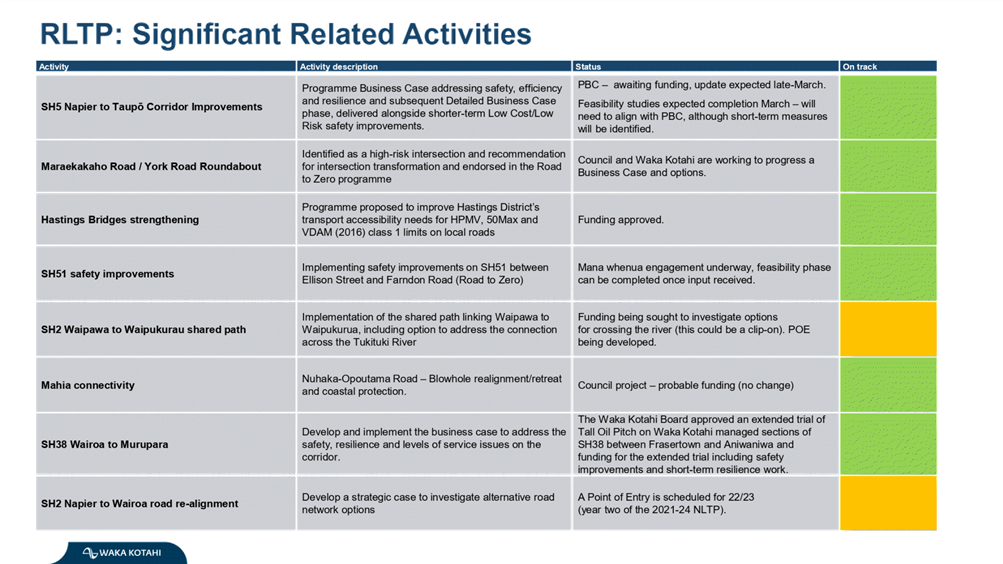

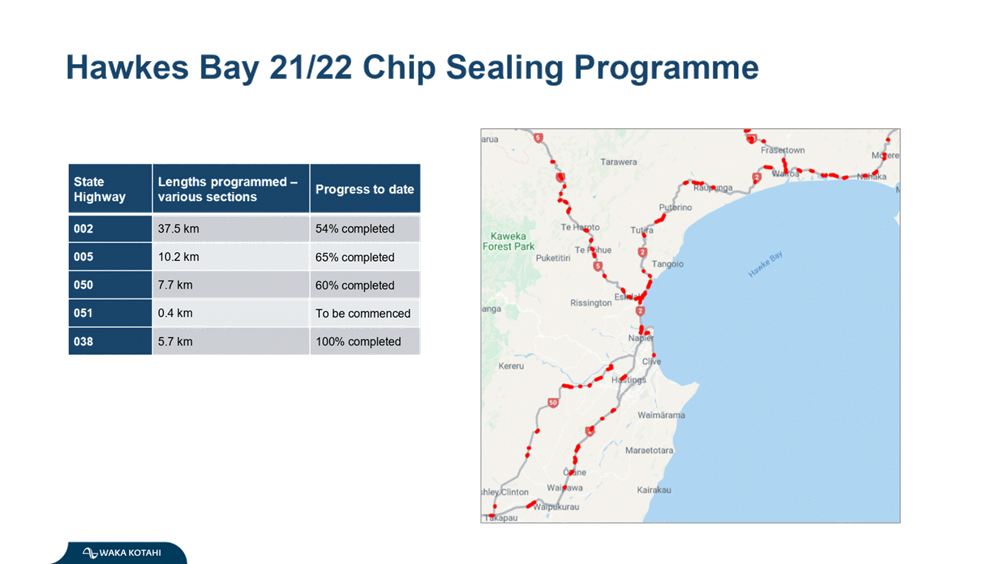
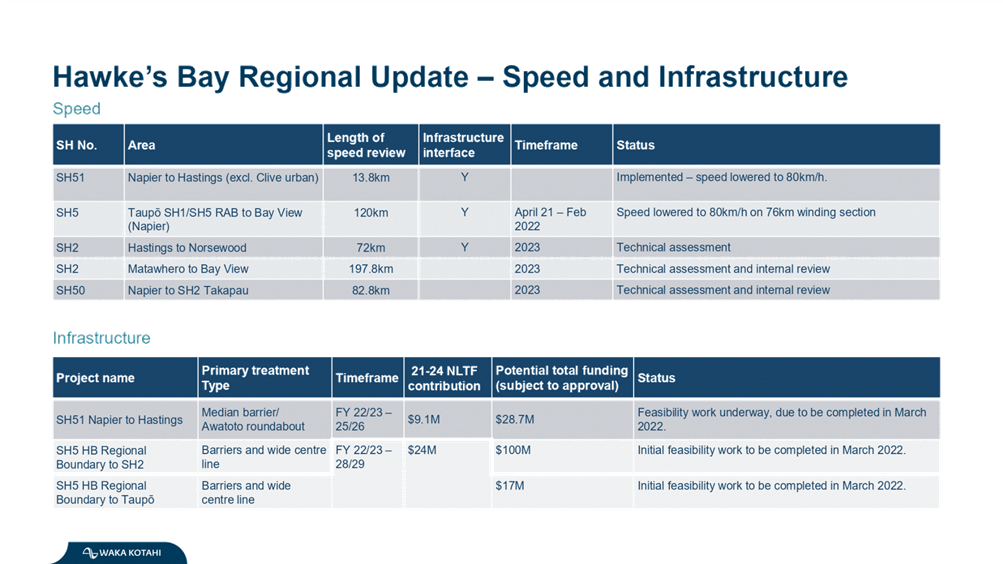
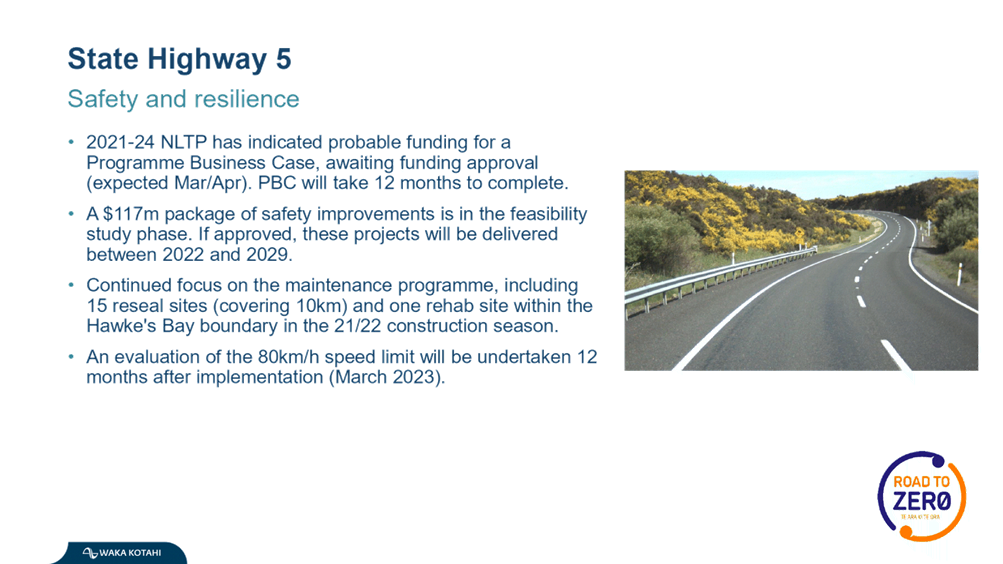
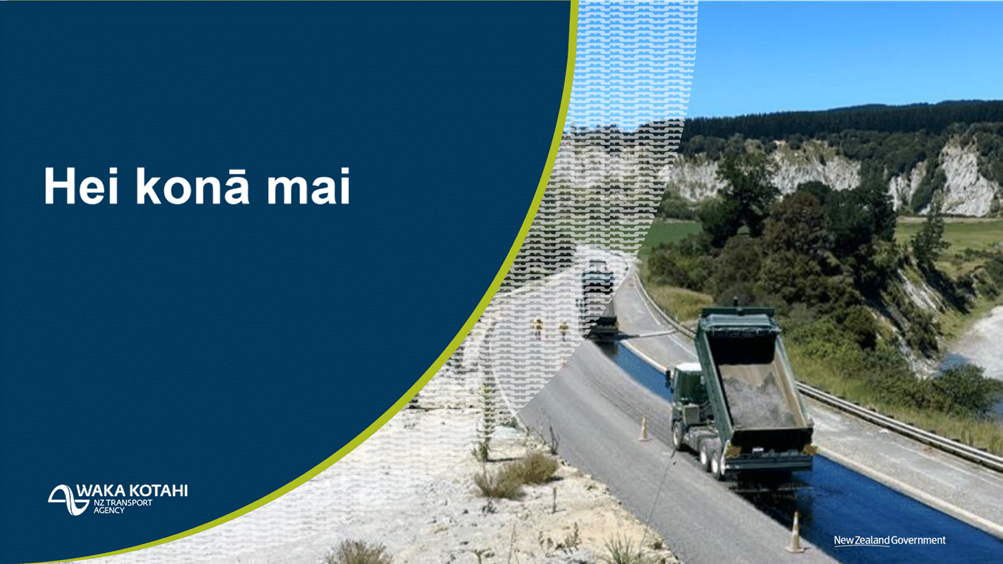
HAWKE’S BAY REGIONAL
COUNCIL
Regional
Transport Committee
11 March
2022
Subject: Discussion of Minor Matters
Not on the Agenda
Reason
for Report
1. This document
has been prepared to assist Committee members note the Minor Items Not on the Agenda to be discussed as determined earlier in Agenda Item
5.



































